Galerie Eva Presenhuber is pleased to present an overview of works on paper by Tschabalala Self.
This overview contains both unique works and works from editions from the following series: Early Monoprints (2013 – 2015), Bodega Drawings (2017 – 2019), Black Joy (2019), Black Faces (2020 – 2022), Leisure Drawings (2021 – 2022), Homebodies (2022 – 2023) and Home Alone (2022 – 2023). There are works contained within this overview which are still available, and several archival works which are now in public and private collections.
Galerie Eva Presenhuber would like to draw particular attention to the Home Alone series which will be premiered at Art Basel Miami Beach. The large-scale, unique work Lonely Girls #1 from the Home Alone series will be featured prominently in the gallery’s presentation at Art Basel Miami Beach in December 2023 (Booth C29), along with the new painting Chocolate Drop of which the subject matter is related.
Also included in the overview is an essay on Self’s work by Claire Gilman, Chief Curator at The Drawing Center.
Please click HERE for a comprehensive list of available works.
PRINTED EDITIONS
THE REFUSAL
The Refusal is a reinterpretation of the painting No (2019). It shows a strong and stoic female figure.
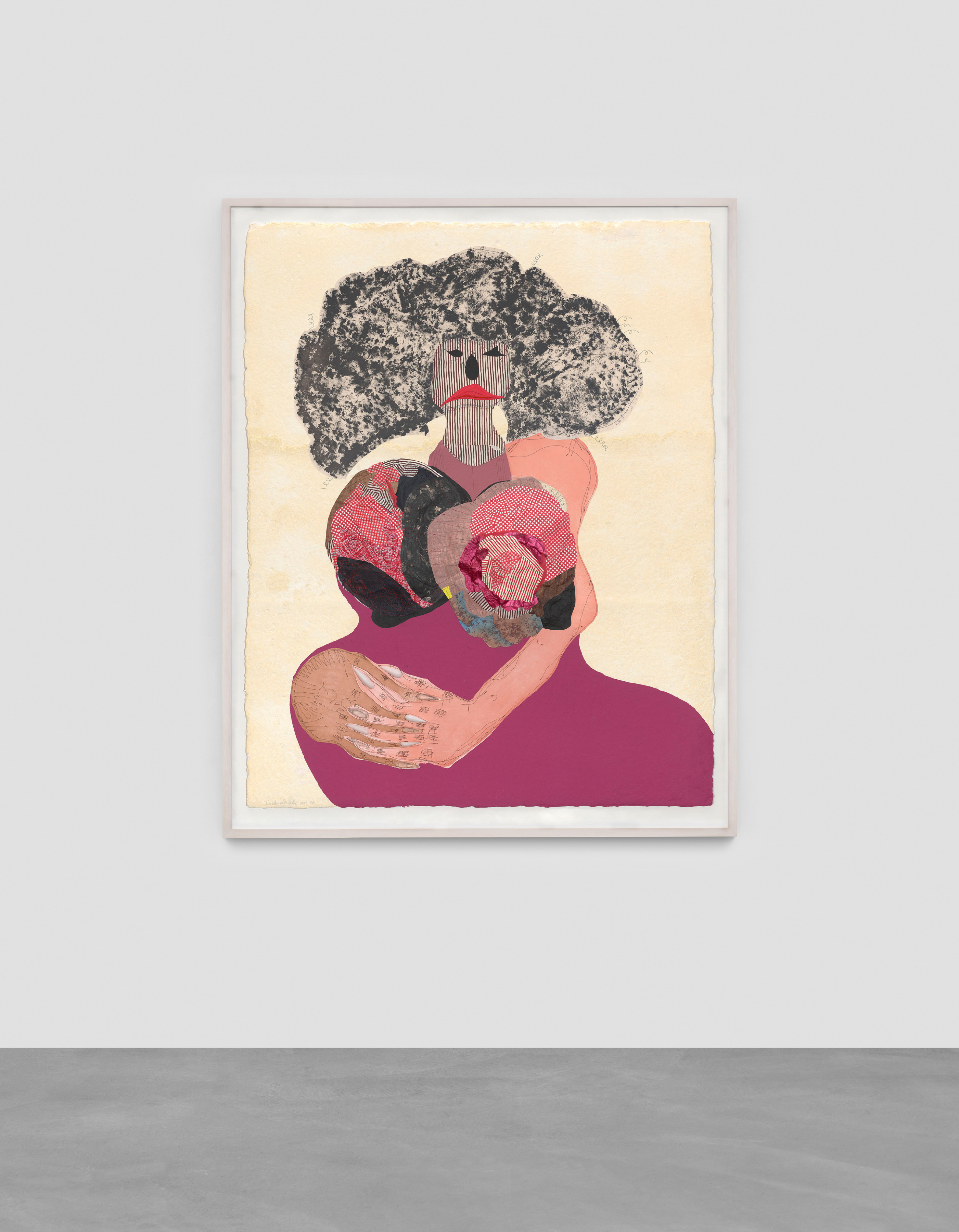
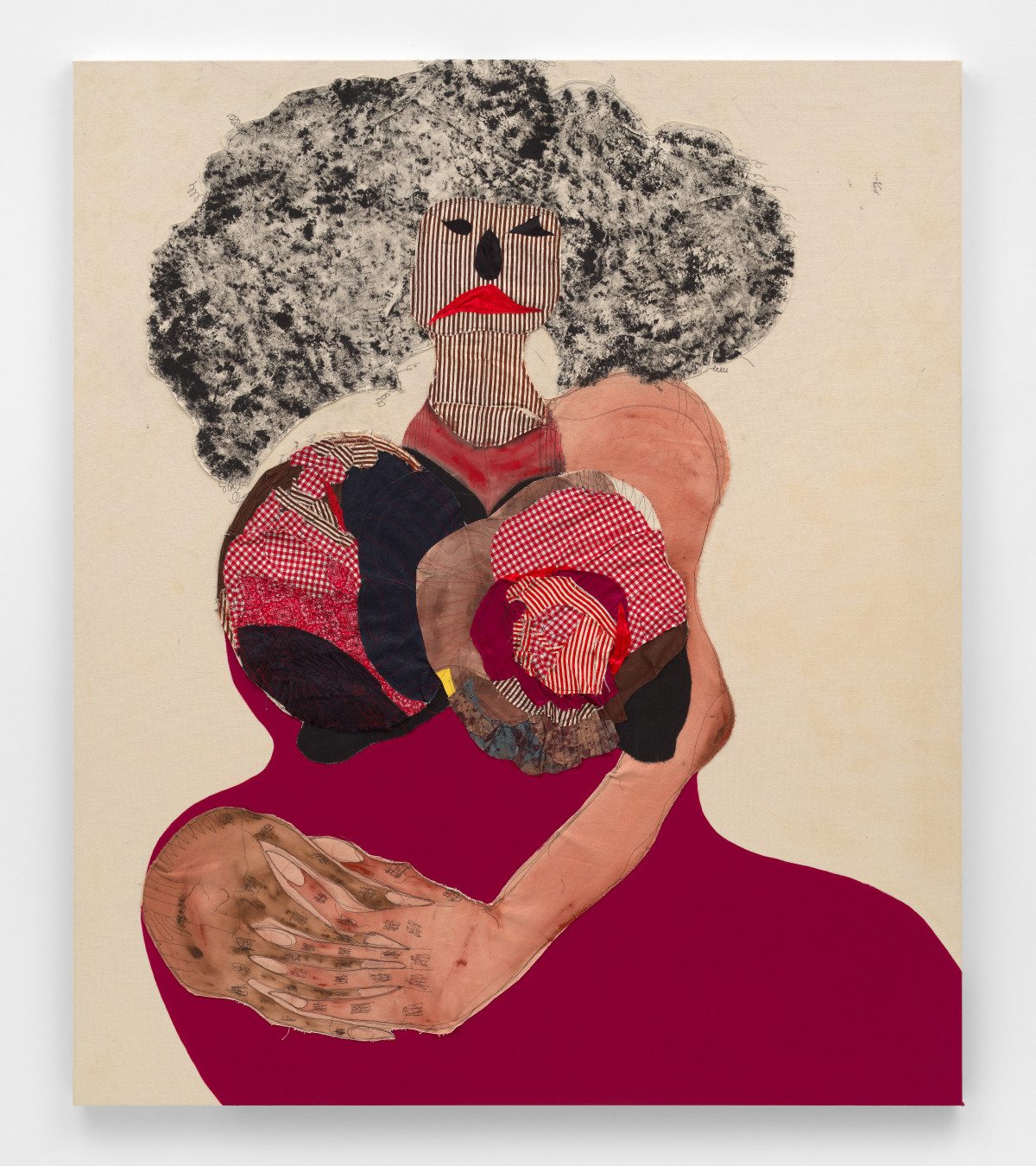
The print relates to this painting:
TSCHABALALA SELF
No
2019
Fabric, acrylic, Flashe and painted canvas on canvas
213.5 x 183 x 4.5 cm / 84 x 72 x 1 3/4 in
SELF 46667
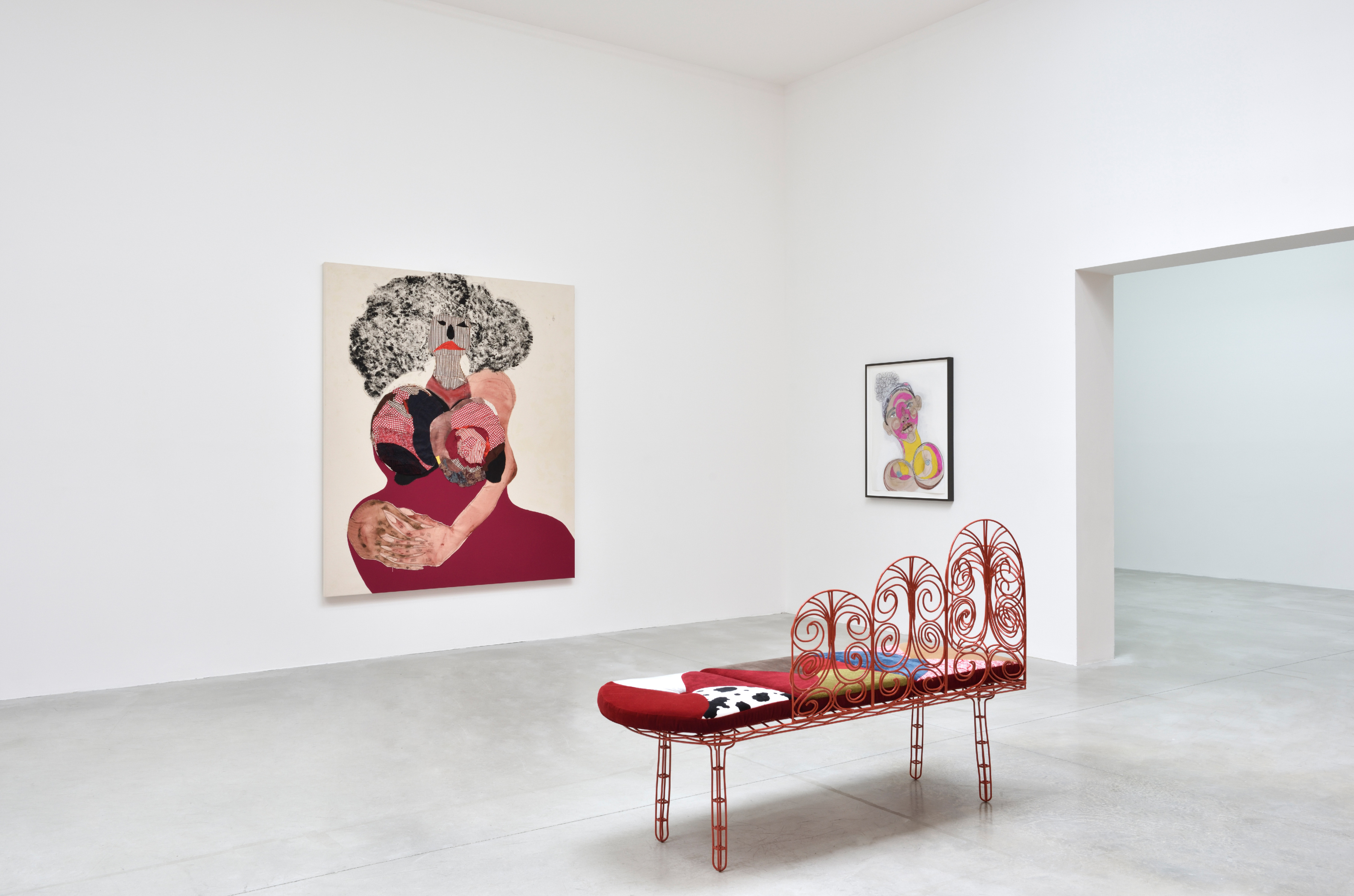
Installation view, Tschabalala Self, Make Room, Consortium Museum, Dijon, 2022
MISTA & MIS'ESS
Mista and Mis'ess is a reinterpretation of Mista & Mrs (2016). It shows a loving couple steppin in unison.
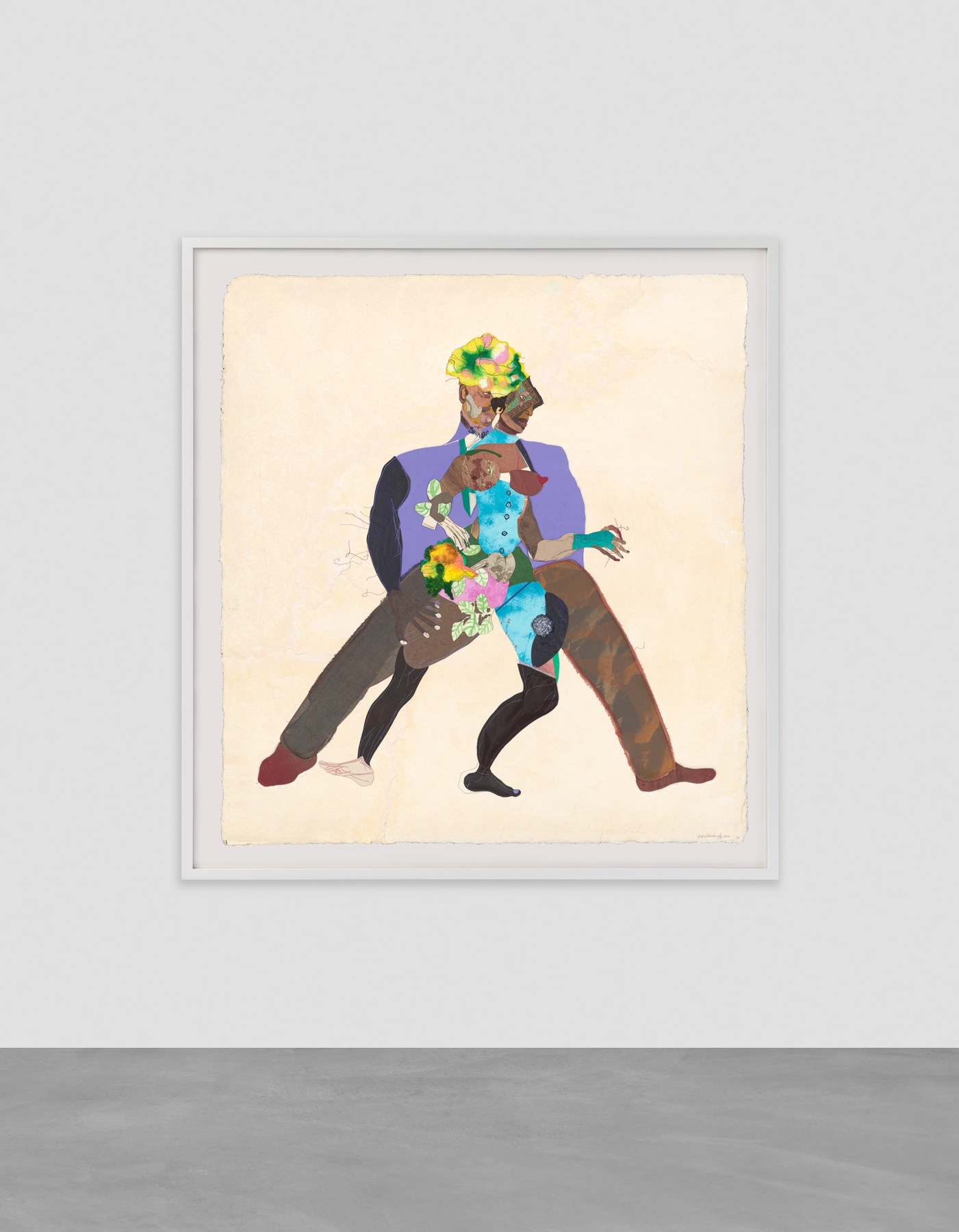
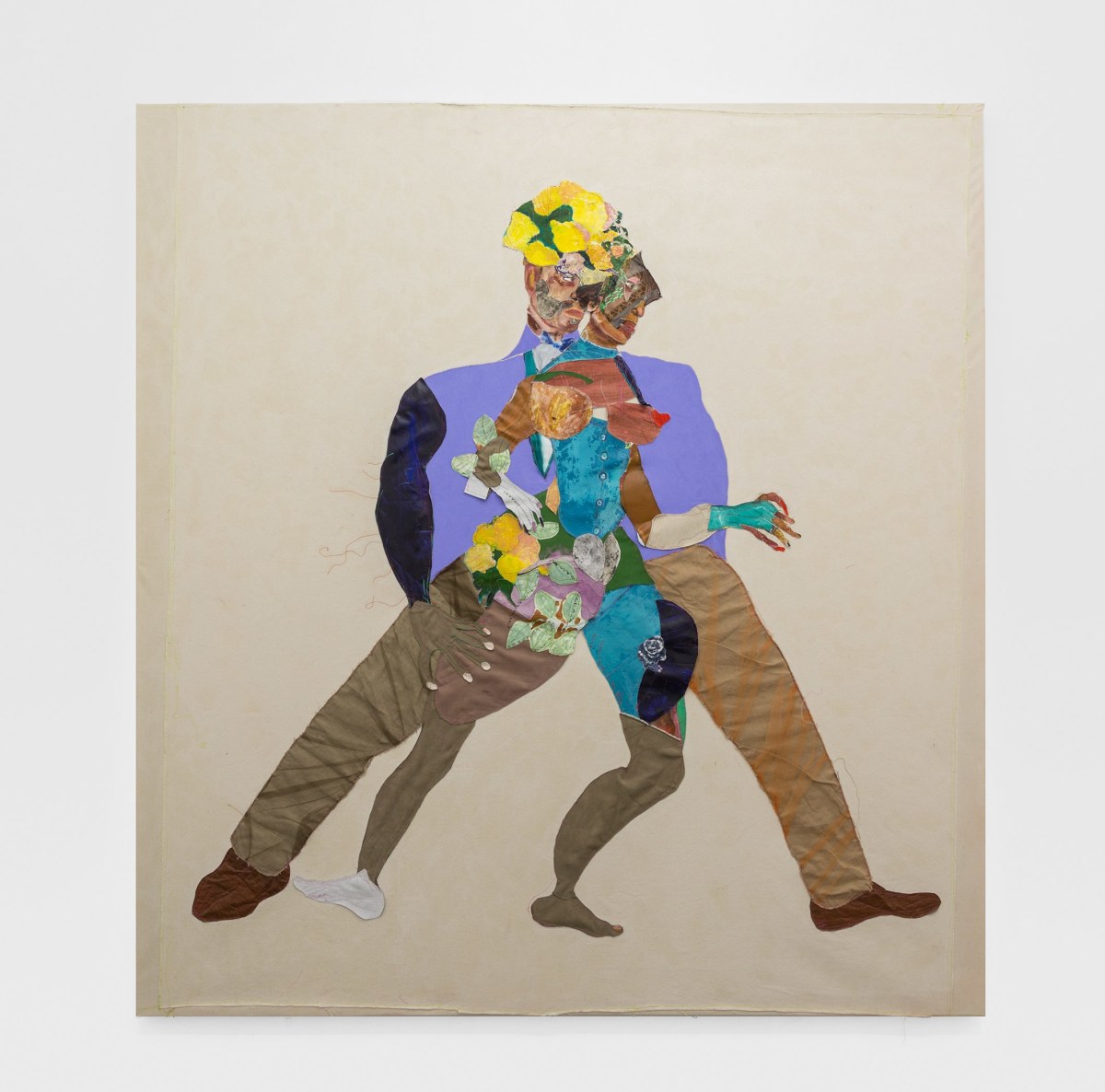
The print relates to this painting:
TSCHABALALA SELF
Mista & Mrs.
2016
Linen, fabric, paper, oil, acrylic, and Flashe on canvas
244 x 228.5 cm / 96 x 90 in
SELF 46793
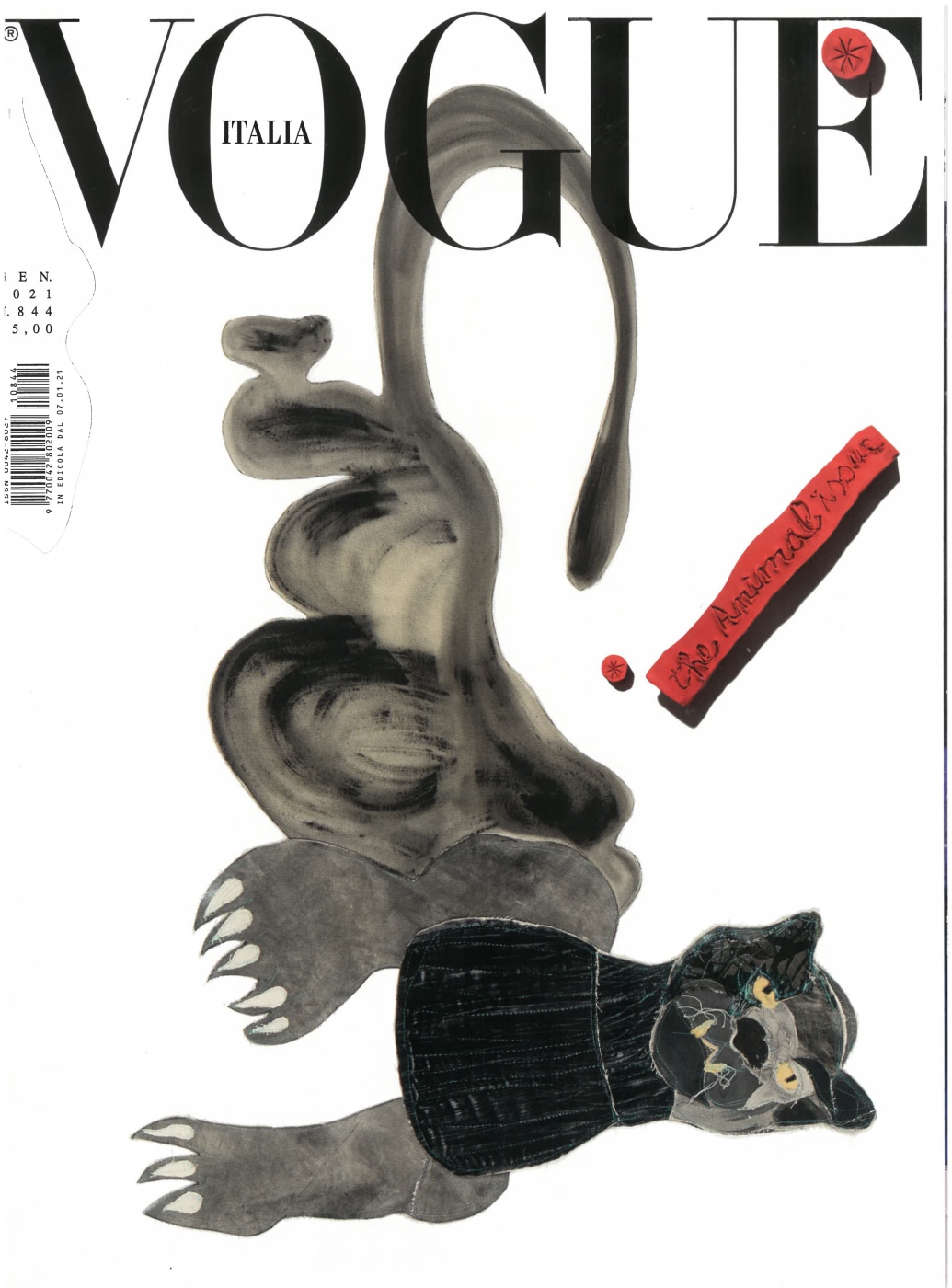
Vogue Italia, January Issue, 2021
BLACK PANTHER
Self’s newest edition sees the artist translate the Black Panther Party’s iconic symbol into a large-scale etching. The work is comprised of seven plates and employs a mix of etching techniques including soft ground, spit bite, open bite and gravure. Several of these etching techniques mimic the patterns of manufactured fabric while others are gestural, showing the artist’s hand. These textural differences in each of the seven plates, along with the gold leafing of the eyes of the panther, create distinct patterns and swirls of tone that appear collaged together, mirroring the approach of the use of fabric and layered materials in Self’s canvas works. The panther appears on a white void, highlighting its status as a symbol while also showing the plate edge and emphasizing the dimensional effect of pressing. The image is encased in a frame painted with the colors of the Pan-African flag, placing it in context of a movement celebrating Black liberation in the United States.
In a speech delivered at the 1966 Students for a Democratic Society (SDS)-sponsored “Black Power and its Challenges“ conference at U.C. Berkeley, activist and organizer Stokely Carmichael said, “We chose for the emblem a black panther, a beautiful black animal which symbolizes the strength and dignity of black people, an animal that never strikes back until he‘s back so far into the wall, he‘s got nothing to do but spring out. Yeah. And when he springs he does not stop.”
HOMEBODIES
Homebodies is a series of work which explores the psychological significance of the home. The series was first featured in Self’s 2022 exhibition, Homebody, at Pilar Corrias Gallery in London. The paintings in this show function as windows into the home, which serve as a metaphor for a general sense of interiority. Groupings of intimate vignettes situate Self’s chorus of imagined characters within domestic scenes. Home body, a colloquial term for an introvert who prefers to stay within the confines of the home, underscores the inherent tensions at work in domestic settings, where socially-prescribed identity and gender politics still furnish our so-called ‘safe spaces’.
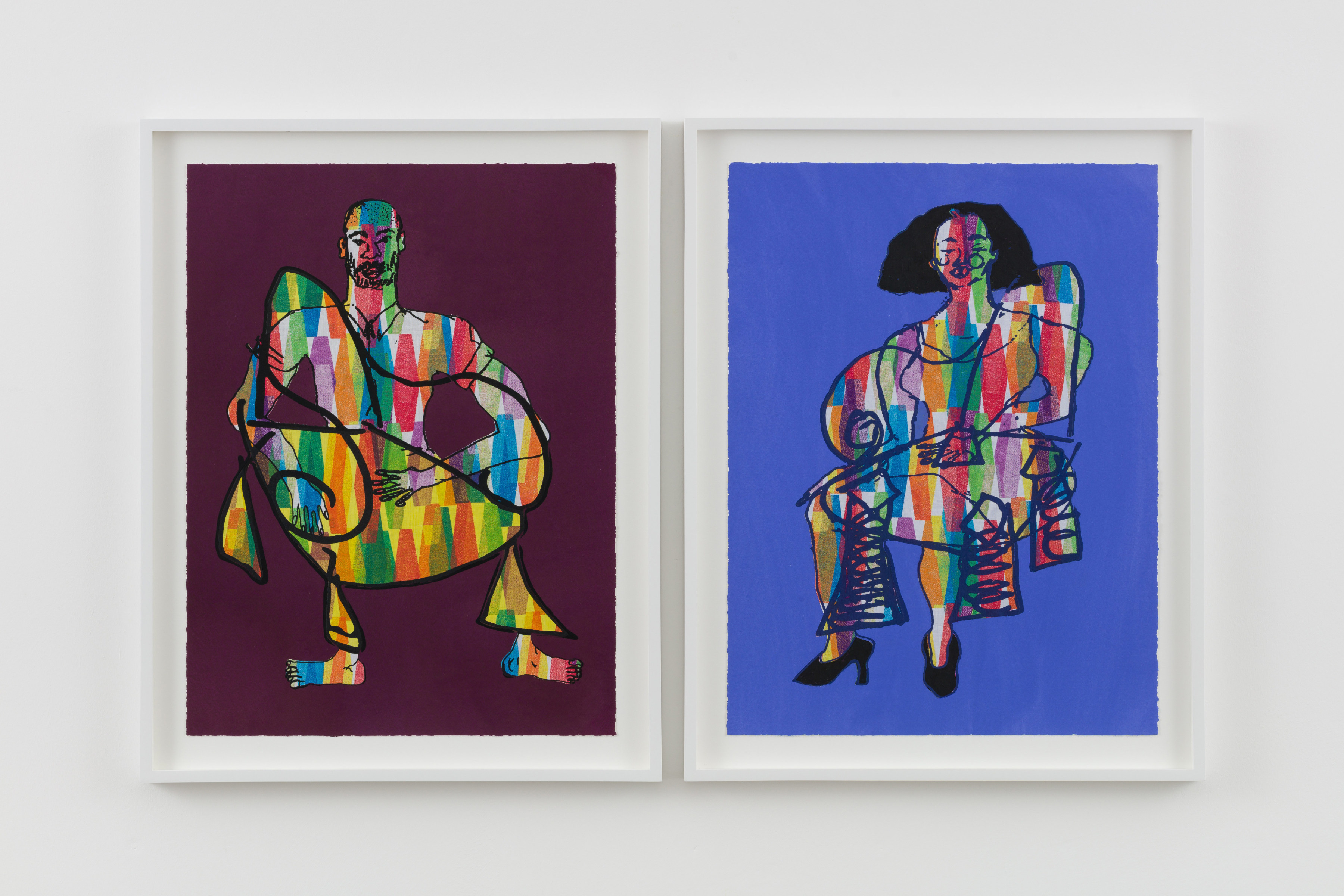
TSCHABALALA SELF
Homebodies - Hexed
2022
Set of two monoprints (fabric collage, pigment wash, hand coloring, and enamel silkscreen on Saunders Waterford 425gsm paper)
Unique variation 7/18 + 3 AP
2 prints, each 61 x 45.5 cm / 24 x 18 in
Frames, each 70.5 x 55.5 cm / 27 3/4 x 21 7/8 in
SELF 58336
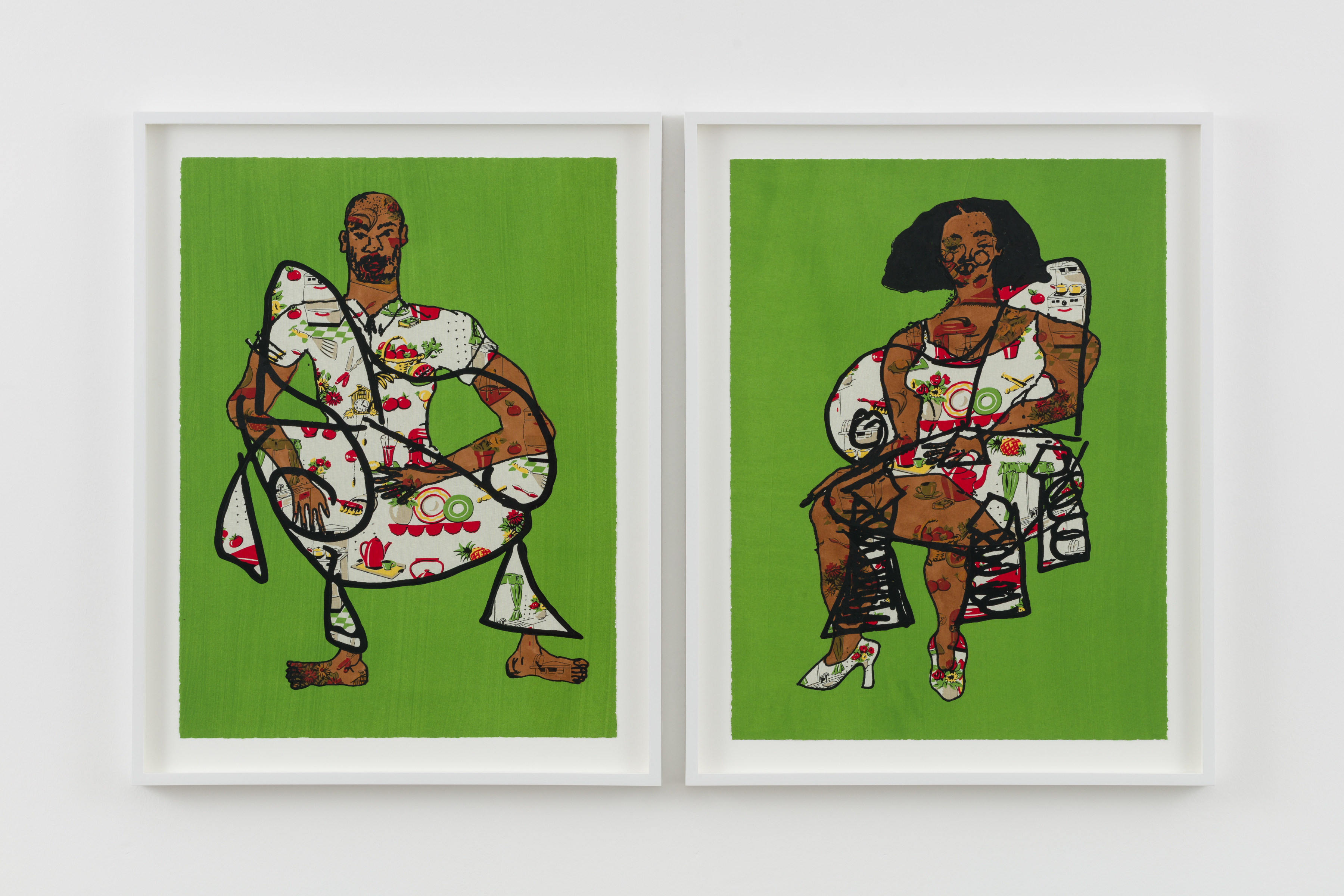
TSCHABALALA SELF
Homebodies - Tempted
2022
Set of two monoprints (fabric collage, pigment wash, hand coloring, and enamel silkscreen on Saunders Waterford 425gsm paper)
Unique variation 10/18 + 3 AP
2 prints, each 61 x 45.5 cm / 24 x 18 in
Frames, each 70.5 x 55.5 cm / 27 3/4 x 21 7/8 in
SELF 58438
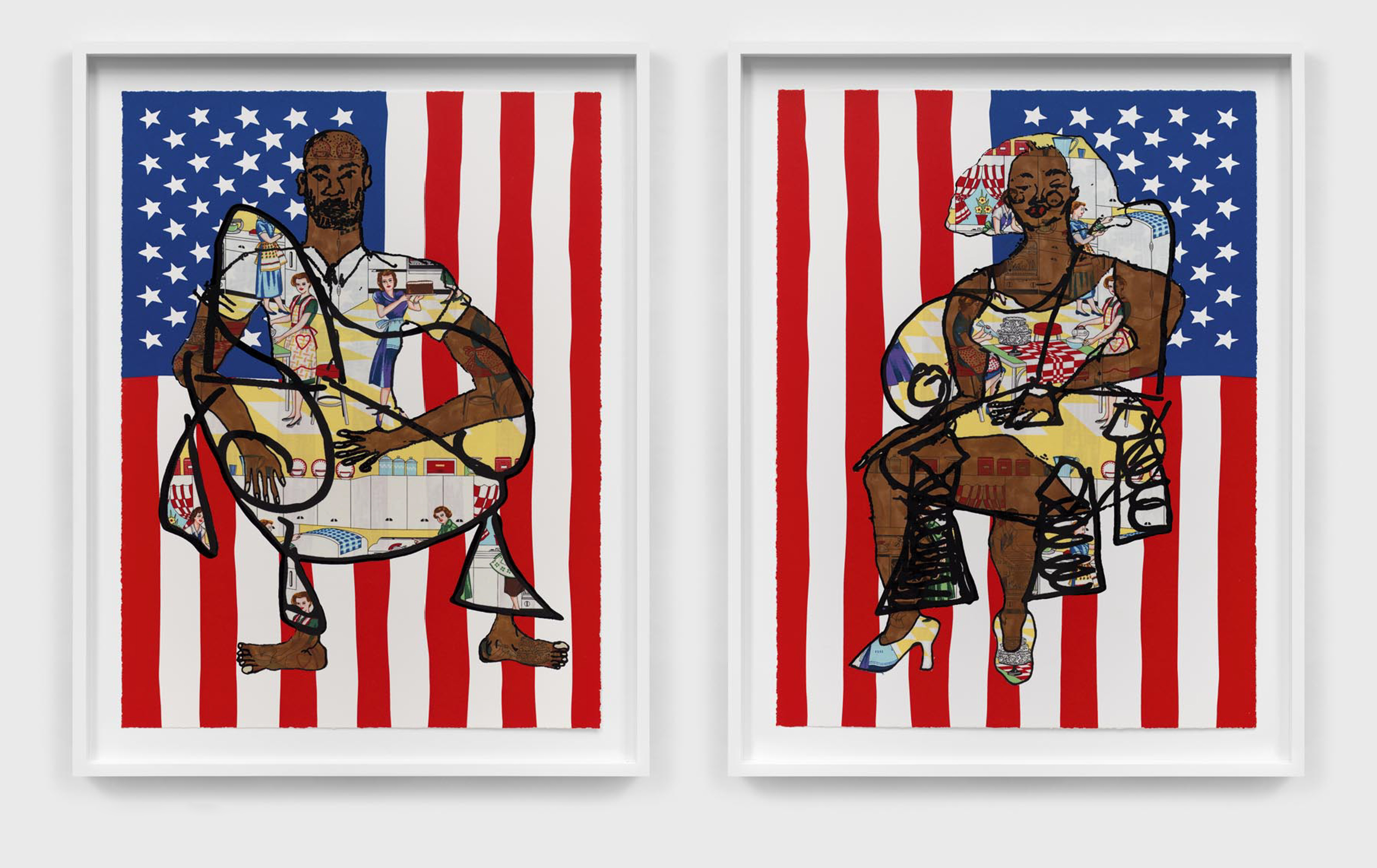
TSCHABALALA SELF
Homebodies - All American 3
2022
Colored pencil, acrylic paint, gouache, charcoal, and graphite on archival inkjet print
Unique variation 10/18 + 3 AP
2 prints, each 61 x 45.5 cm / 24 x 18 in
Frames, each 70.5 x 55.5 cm / 27 3/4 x 21 7/8 in
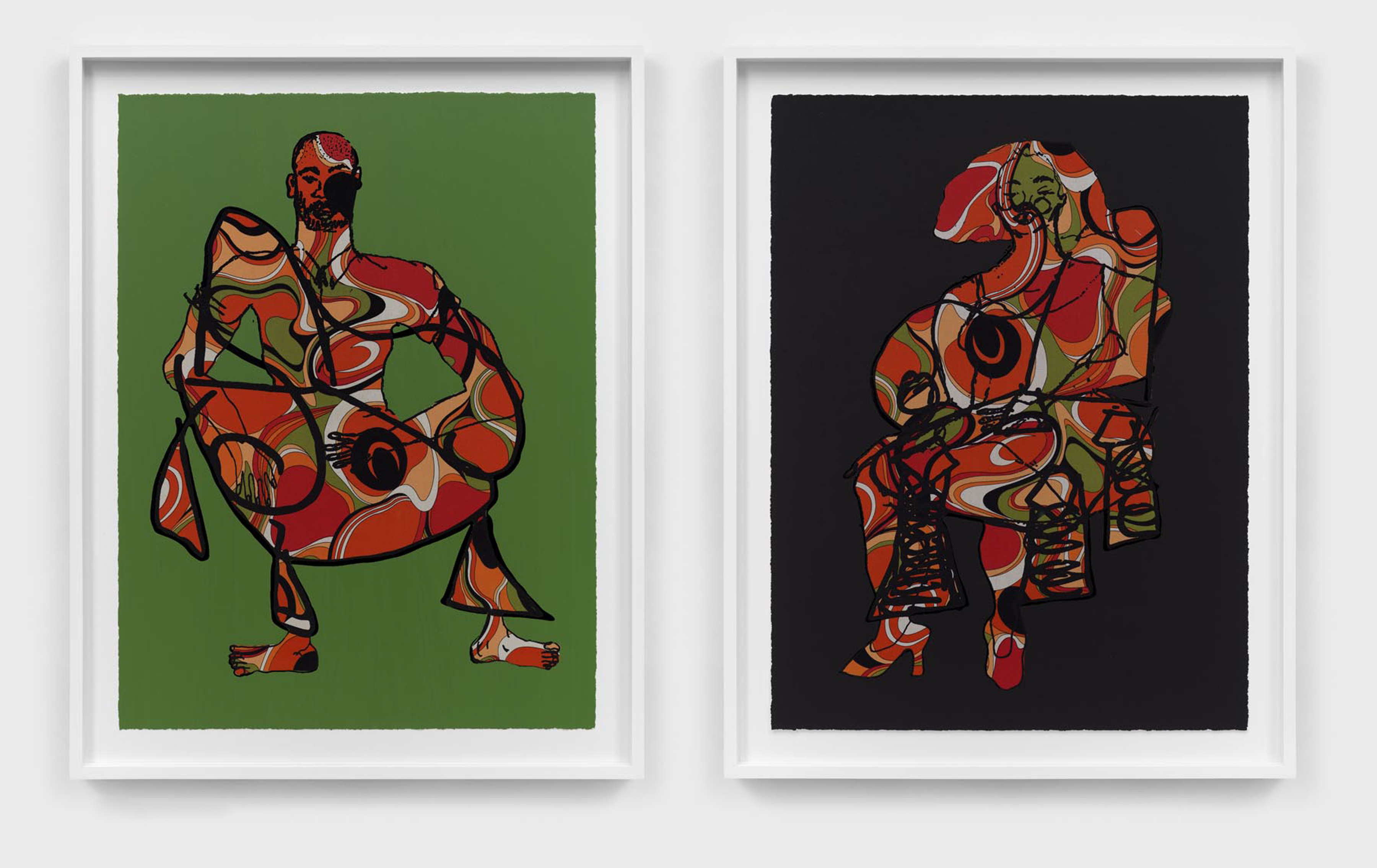
TSCHABALALA SELF
Homebodies - Pinned-Up
2022
Colored pencil, acrylic paint, gouache, charcoal, and graphite on archival inkjet print
Unique variation 10/18 + 3 AP
2 prints, each 61 x 45.5 cm / 24 x 18 in
Frames, each 70.5 x 55.5 cm / 27 3/4 x 21 7/8 in
HOME ALONE
Lonely Girls #1, Lonely Girls #2 and the Home Alone series are a reinterpretation of Midnight (2022).
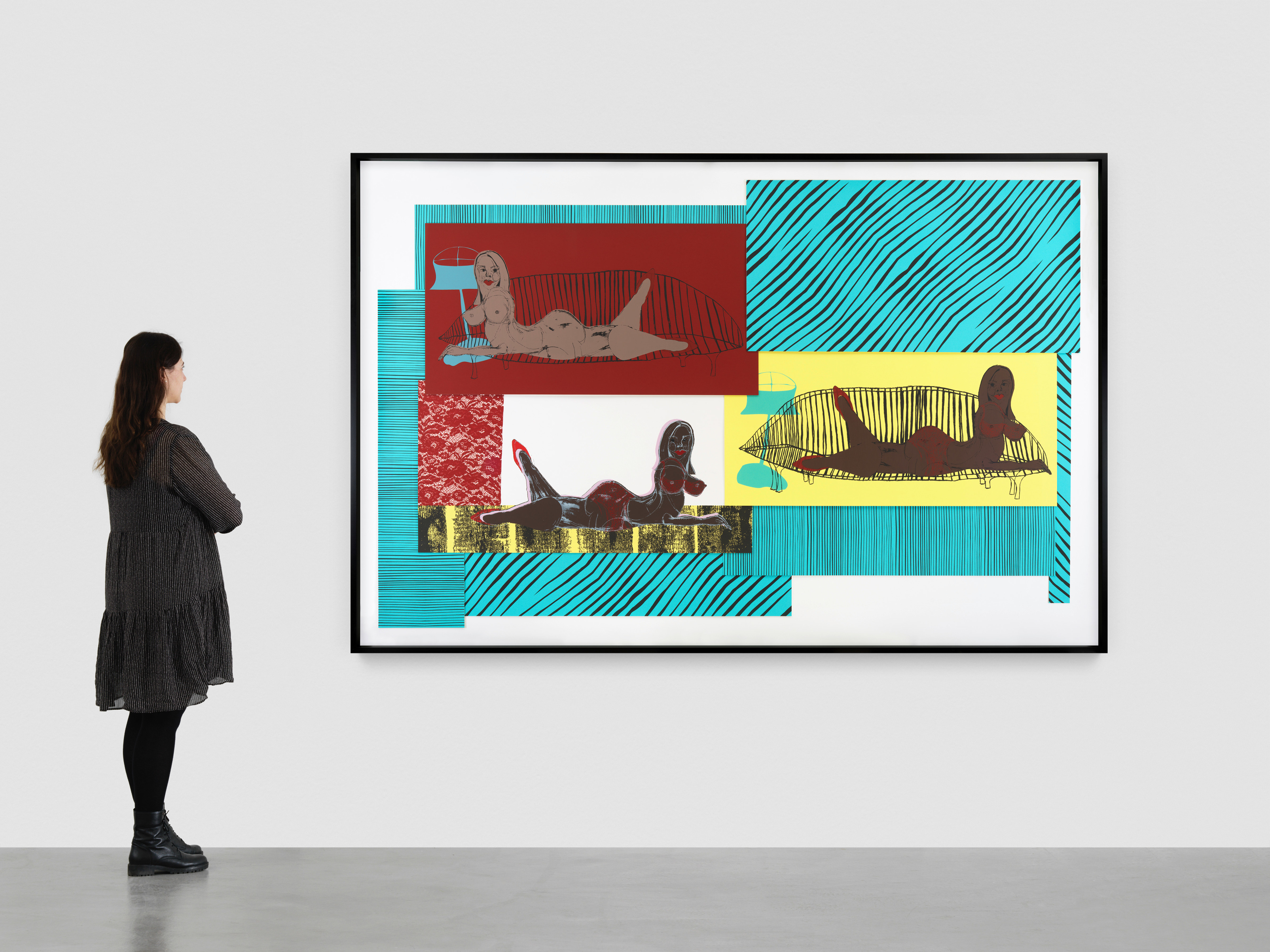
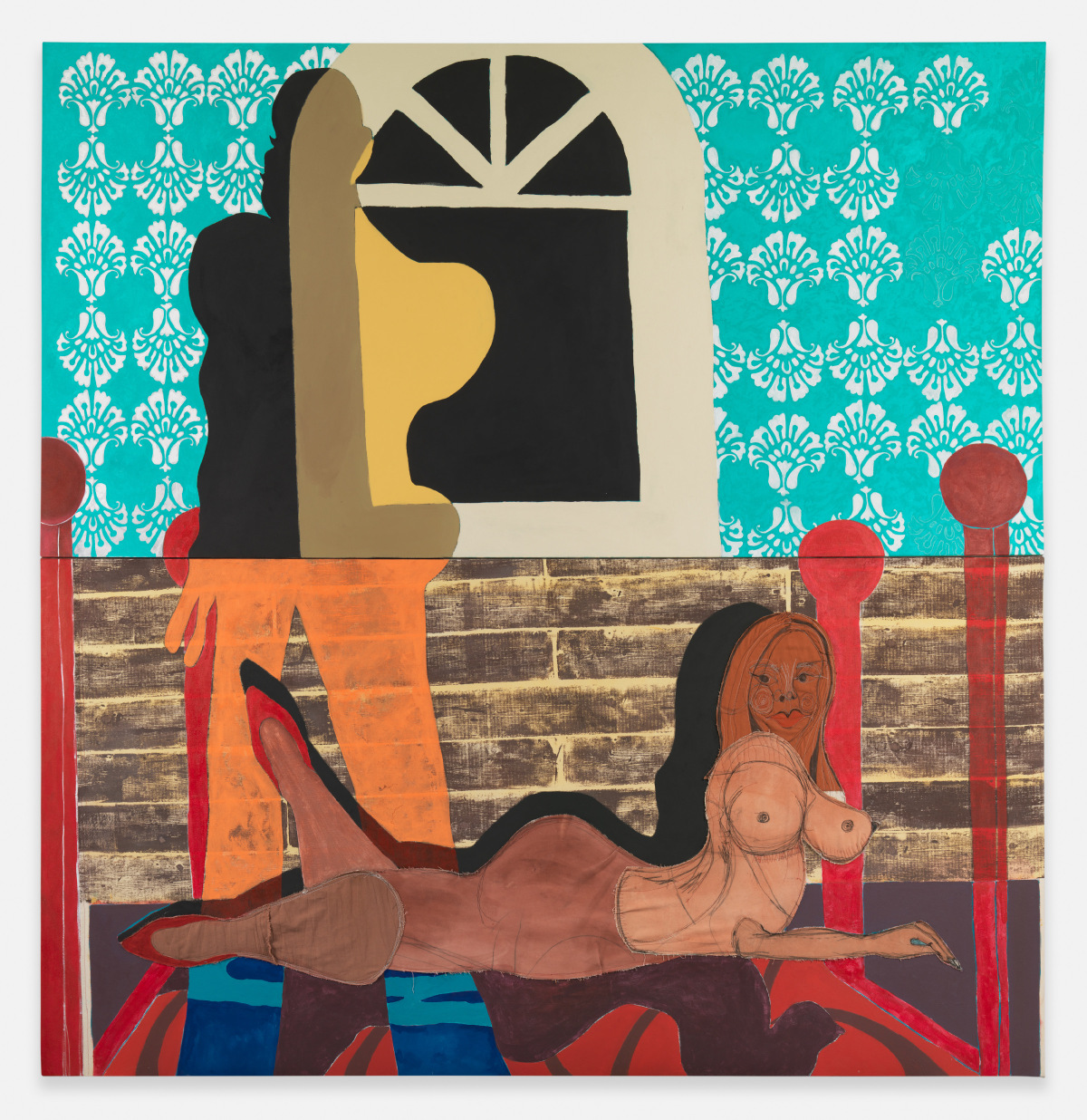
The series relate to this painting:
TSCHABALALA SELF
Midnight
2022
Fabric, pastel, charcoal, pencil, acrylic paint, oil paint and hand-printed canvas on canvas; 2 parts
Total dims. 244 x 244 cm / 96 x 96 in
SELF 50613
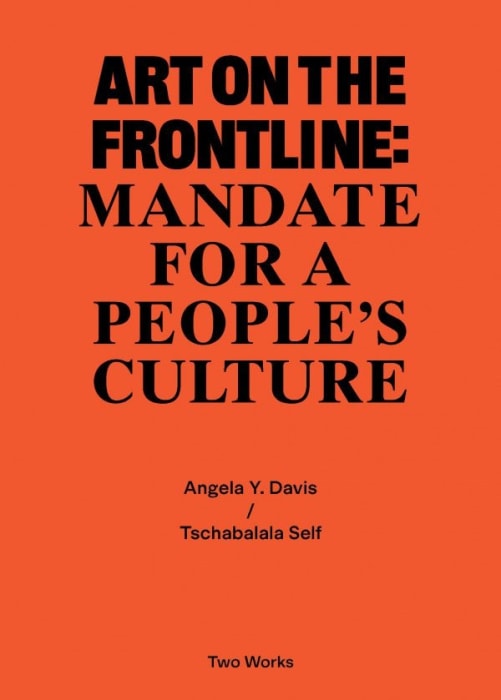
Amber Husain/Mark Lewis (edited by), Art on the Frontline: Mandate for a People‘s Culture. Angela Y. Davis/Tschabalala Self, London, 2021
HISTORY OF DRAWINGS
Repetition and Community in the Work of Tschabalala Self
by Claire Gilman, Chief Curator at The Drawing Center, June 2021
Repetition, long considered the purview of artistic mediums like printmaking, photography, film and video, is less typically associated with drawing, the art form that, more than any other, is synonymous with the unique, personal impression registered in the moment, and once and for all. And yet, this view is predicated on a particular notion of repetition, one that equates repetition with simulation and stasis, and that fails to grasp the movement and change that any attempt at manual reproduction necessarily implies. In the words of French philosopher Gilles Deleuze, to repeat is not to generate a series of empty signs that undo singularity. Rather, “repetition as a conduct and as a point of view concerns non-exchangeable and non-substitutable singularities” that reject the very notion of a “perfect” model or essential rendition or meaning. According to Deleuze, repetition is, in this sense, a “transgression.” It introduces “disequilibrium” in a process that is predicated on real movement and that understands repetition’s assault on originality as the precondition for true collectivity.
It is in this spirit that I approach Tschabalala Self’s recent body of work, a series of drawings and videos—as well as a work in sculpture and neon—inspired by the publication of Angela Davis’s landmark essay “Art on the Frontline: Mandate for a People’s Culture” by Afterall books for which Self was asked to provide the illustrations. In the essay, Davis asks how we create true social consciousness to which Self responded with a series of portraits of three individuals repeated multiple times with slight variation. Writing about this series, Self observes: “The series entitled ‘Black Faces’ shows the various expressions of 3 individual subjects. These subjects stare inquisitively out of the picture plane at the viewer and perhaps one another. Collectively the works emerge as something greater than their individual parts. Together this grouping becomes a community of sorts with a shared social consciousness. Their gazes shift in moments from disdain, to joy and even mockery -- mimicking the various ebbs and flows of any philosophical didactic.”
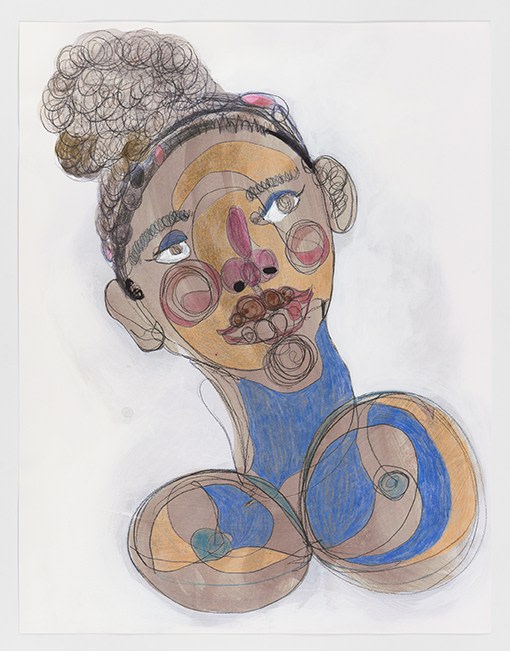
TSCHABALALA SELF
Black Face with Long Blue Neck
2020
Colored pencil, acrylic paint, gouache, charcoal, graphite on archival inkjet print
Sheet 91.5 x 71 cm / 36 x 28 in
Frame 114.5 x 94.5 x 4 cm / 45 x 37 1/4 x 1 1/2 in
SELF 47792
Self produced this series by first enlarging original drawings as ink jet prints and then adding colored pencil, acrylic paint, gouache, and charcoal to the resultant surface so that it is unclear which marks are first and which second-hand. Neither do the marks stay “in place,” migrating as they seem to do from one face to the next. Here, a thin, loose, looping line defines the tangle of a female figure’s top-knot as well as the contours of her cheeks and chin. There, it articulates a male figure’s facial hair as well as his round apple cheeks. As these figures repeat with varied hues and expressions, we become cognizant of a group of individuals who are inextricably connected and ever-changing. Identity, Self’s portraits suggest, is not a stable, self-enclosed phenomenon. Rather, it fluctuates and grows. It is a process of accumulation and layers. And it is also dependent on self-presentation. In Black Face with Rainbow Swirl Vivid, the male face appears on a lime-green-painted piece of paper “collaged” on a rainbow ground. With his yellow-and-pink spiral cheeks, rosy lips and fuchsia hair, he is exuberantly present. And yet, his presence is cosmetic, refusing penetration as his washy face sits atop his transparent green plane superimposed on a similarly washy ground. As titles like Black Face with Rainbow Swirl Vivid, Black Face Lil Pink and Black Face Gemstone indicate, these subjects form a community distinguished by external display and fashioning. They are “in common” even as they show their individual colors.
And these individual colors both do and do not represent the subjects they define. This is pointedly evident in the stop-motion animations Self made to accompany these drawings, one in bold color and the other comprised of a sequence of simple black-and-white contour drawings. In My Black Ass, a nude figure executed in pen outline with bright color accents gyrates and twerks through a sequence of pulsing frames, turning her smiling face forwards and backwards her behind proudly splayed. Twisting and turning, this dancing figure projects uncontainability, self- confidence and joy as she assumes control of her flickering, metronome-like presentation. It is as though one of the five figures featured in the black-and-white animation Okay has come to life, now zoomed-in on and in vivid technicolor and we perceive the individual within the collective and the collective within the individual.
Repetition and imitation are productive forces here just as they are in the world wherein true collectivity is grounded in inheritance and exchange. Hers is an endless dance hardly confined by the video’s short duration. Like the iterative figures in the drawings, she is both open to us and protected beneath her make-up and shifting frames; at once wholly present and uncontained by her animated incarnation. The constant movement forwards and backwards that Self articulates in this series—the circular motion that resists absorption and resolution—is the stuff and substance of social life.
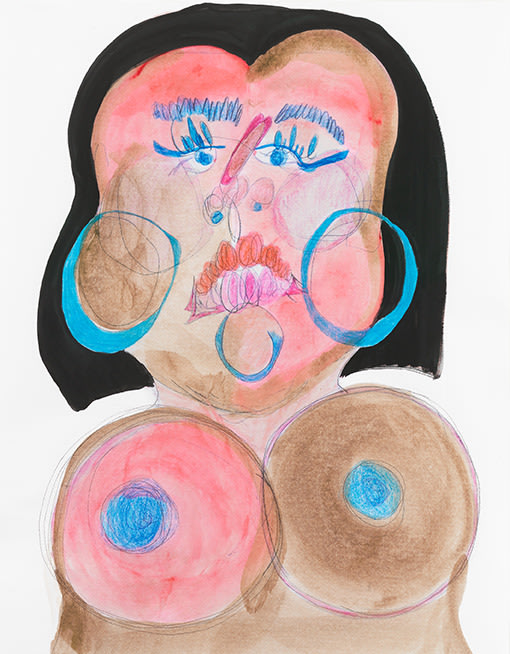
TSCHABALALA SELF
Black Face Red Bone with Black Bob
2021
Coloured pencil, acrylic paint, gouache, charcoal,
graphite, on archival inkjet print
Unique
Frame 86.5 x 106.5 cm / 34 x 42 in
SELF 58402
BLACK FACES (2020 - 2022)
Tschabalala Self‘s subject is the iconography of the Black female body in contemporary culture, but isolated from historical and environmental references, floating free on the canvas - breasts, hips and buttocks flaunted joyously, over-emphasized, sexualized, celebrated. ”I believe in cultivating positivity and optimism in my work“, she says, remarking elsewhere that “the disgusting and perverse violence projected onto the Black body in Western society is an abomination“. If the pale, slimline, adolescent look that the mainstream fashion industry promotes as the paradigm of feminine beauty could be taken as a reproach if not an insult to all women of other shapes and sizes, how much more so to the Black women whose bodies are often viewed as a foil to Eurocentric standards?
Self‘s painting are composed of scraps of cut fabric and paper, sequins, glitter, acrylic, gouache and oil paints and coloured pencil drawing. All of the collaged elements are sewn onto the canvas. Drawing is the starting point and remains an element in some of the paintings, especially the faces. She describes her characters as coloured pencil and watercolour portraits are similar, looking with an air of self-assurance straight at the viewer, wholly on their own terms.
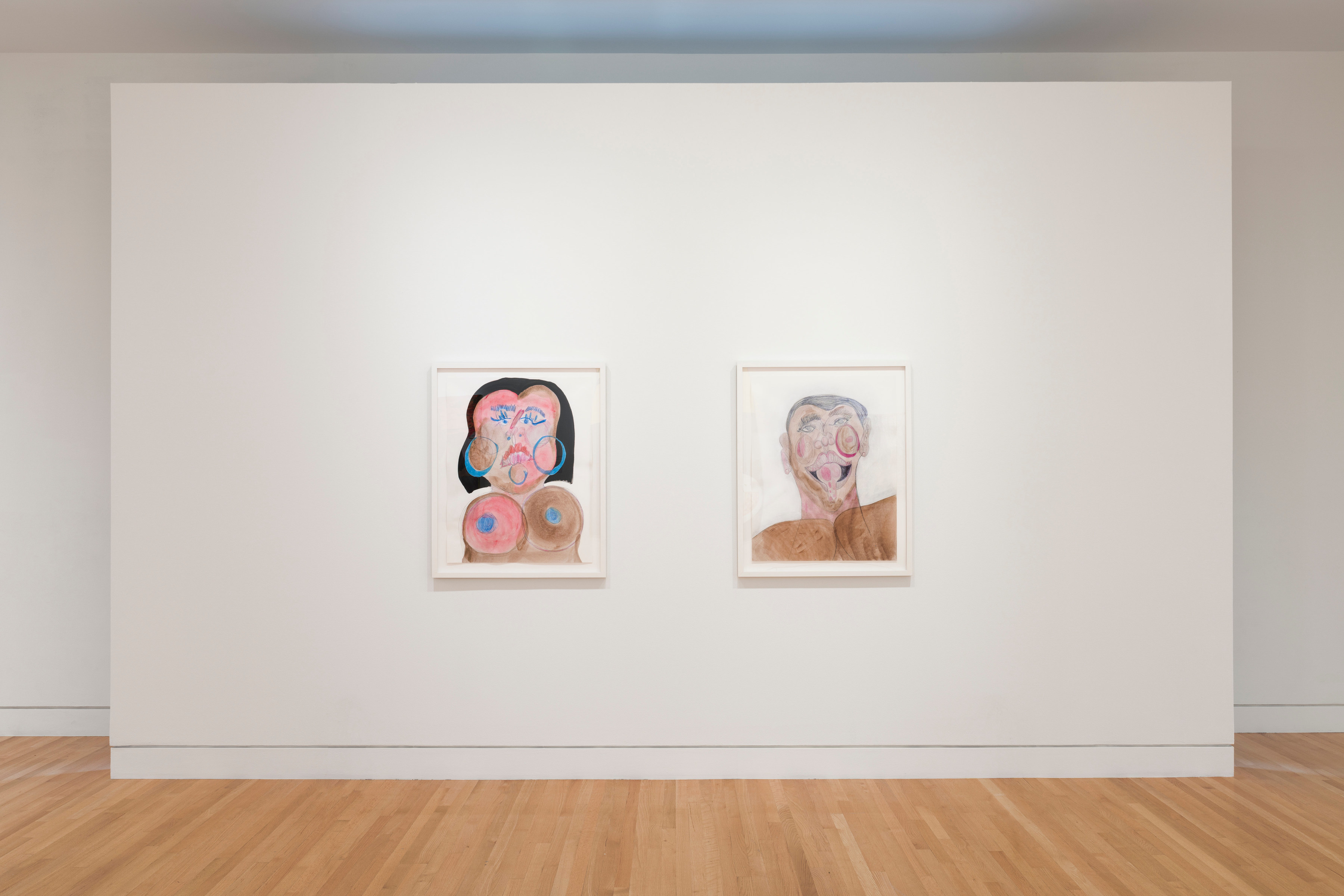
Installation view, A Living Legacy: Recent Acquisition in Contemporary Art, Frye Art Museum, Seattle, Washington, 2023
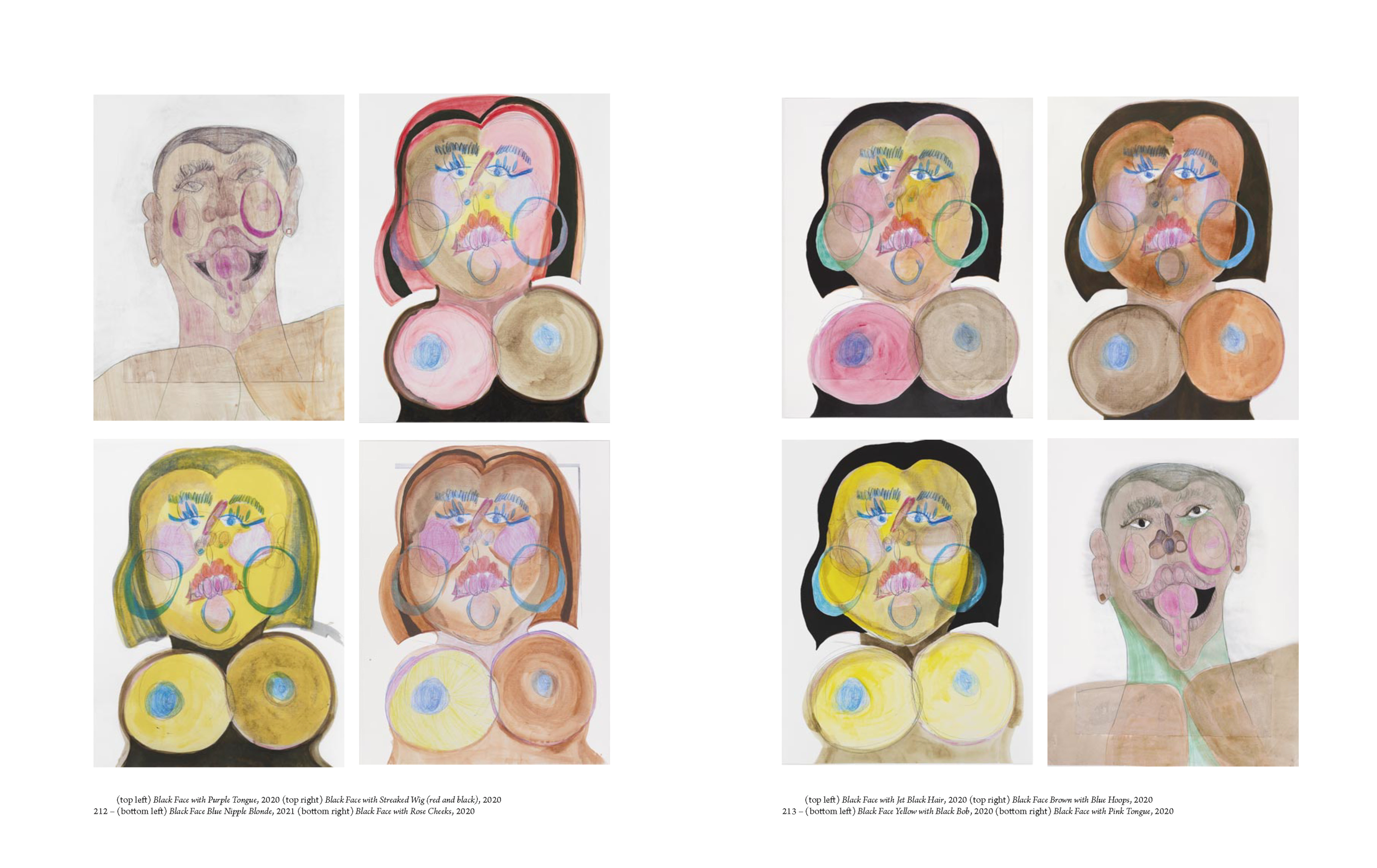
From: Franck Gautherot, Seungdug Kim, Tschabalala Self, Gwyneth Giller (edited by), Tschabalala Self. Make Room, Dijon, 2023, pp. 212 - 213
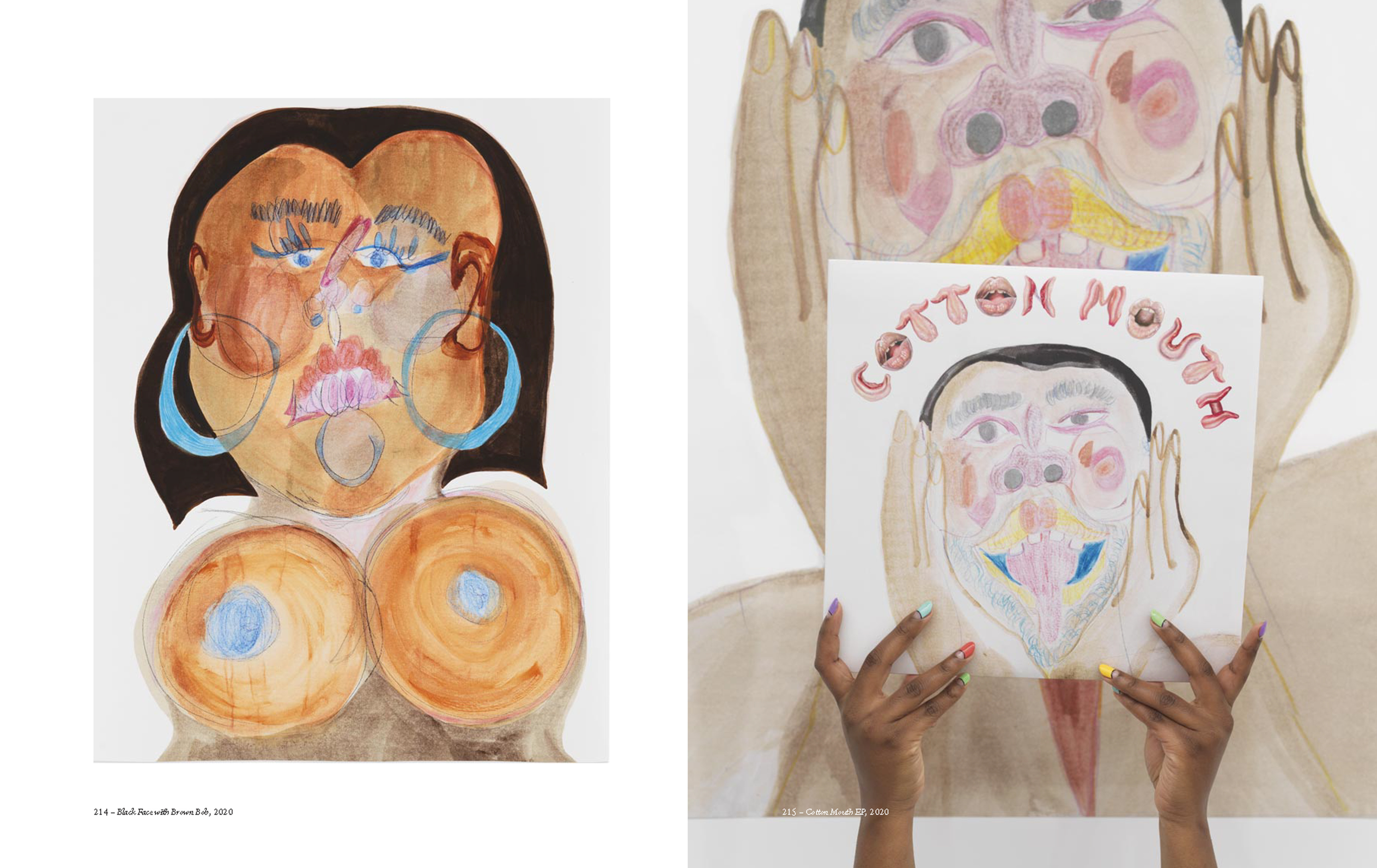
From: Franck Gautherot, Seungdug Kim, Tschabalala Self, Gwyneth Giller (edited by), Tschabalala Self. Make Room, Dijon, 2023, pp. 214 - 215
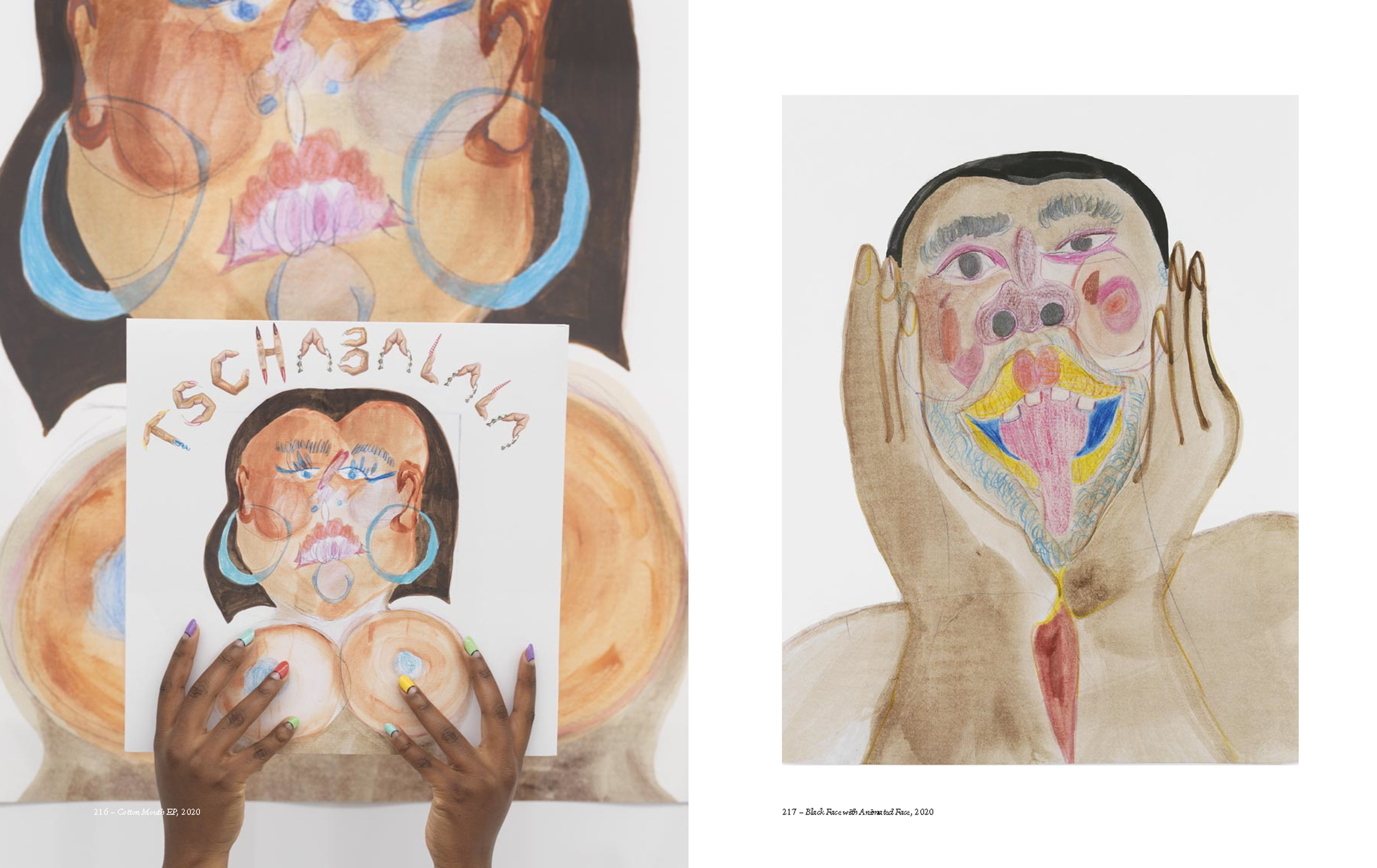
From: Franck Gautherot, Seungdug Kim, Tschabalala Self, Gwyneth Giller (edited by), Tschabalala Self. Make Room, Dijon, 2023, pp. 216 - 217
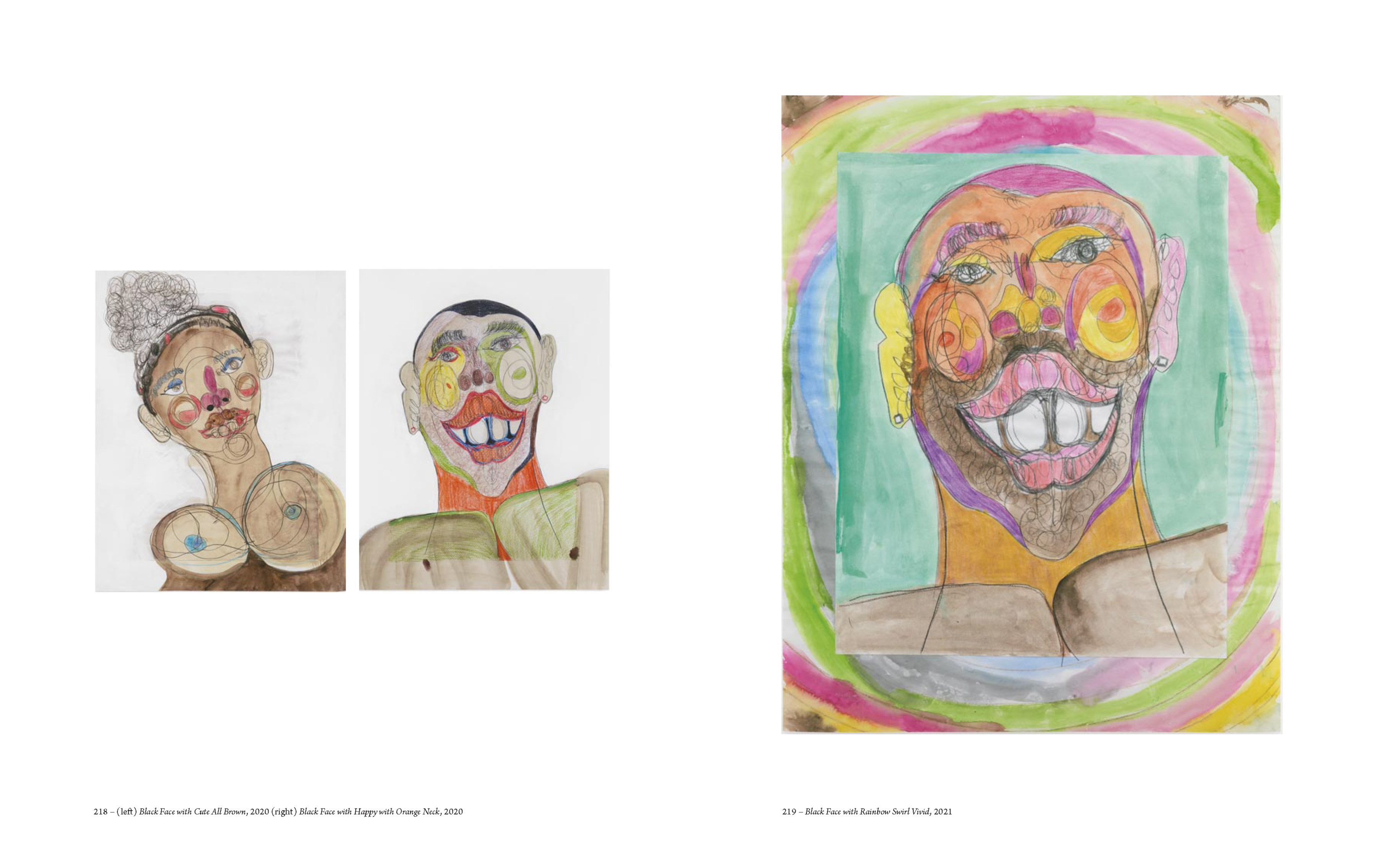
From: Franck Gautherot, Seungdug Kim, Tschabalala Self, Gwyneth Giller (edited by), Tschabalala Self. Make Room, Dijon, 2023, pp. 218 - 219
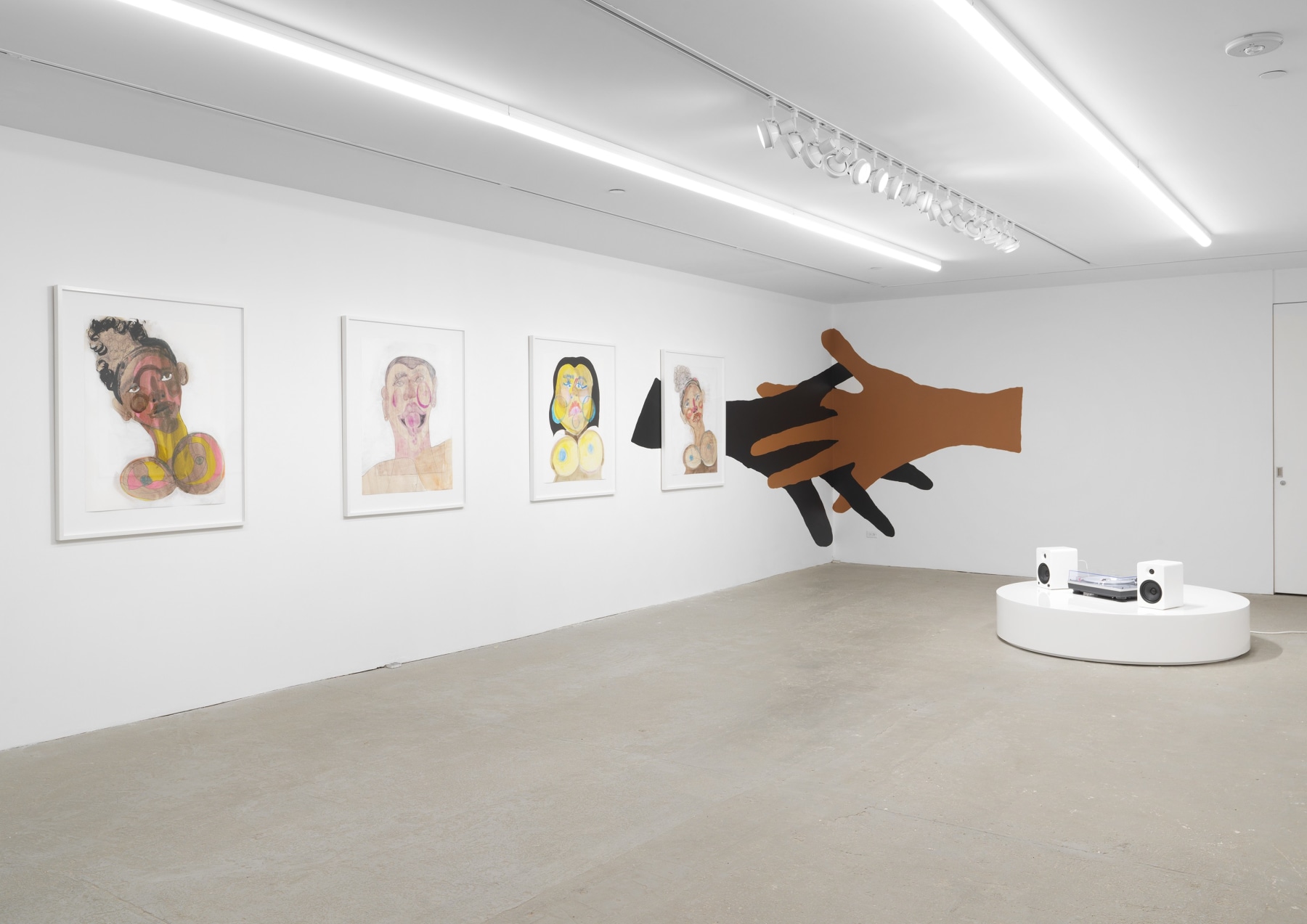
Installation view, Tschabalala Self, Cotton Mouth, Galerie Eva Presenhuber, New York, 2020-2021
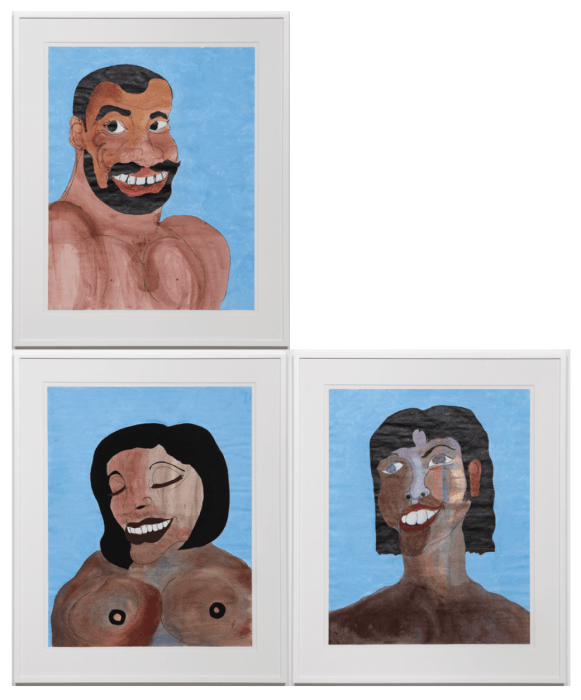
TSCHABALALA SELF
Black Joy 8 - Chocolate Lady with Pretty Teeth, Black Joy 9 - Long Neck, Black Joy 10 - Goodman
2019
Acrylic on paper
each frame 84 x 68.5 cm / 33 x 27 in
SELF 46936
BLACK JOY (2019)
Black Joy is a series depicting the idea of Black happiness which has been spoken about in relation to the widely discussed and understood concept of Black pain. Black Joy glibly references this very complex idea through the simple gesture of a smile.
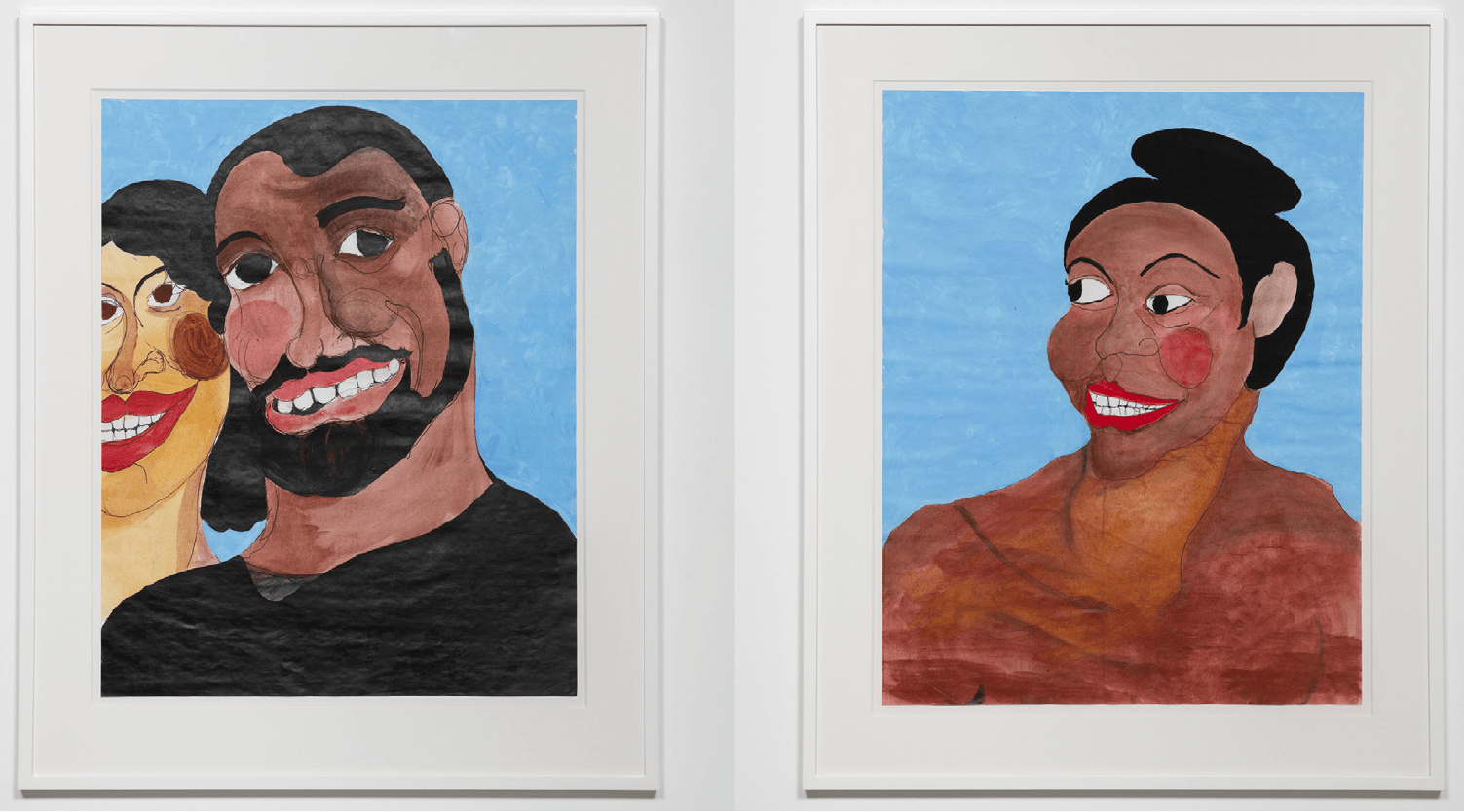
TSCHABALALA SELF
Black Joy 6 – With Yellow Bone, Black Joy 7 – Bun on Top
2019
Acrylic on paper
each frame 84 x 68.5 cm / 33 x 27 in
SELF 46937
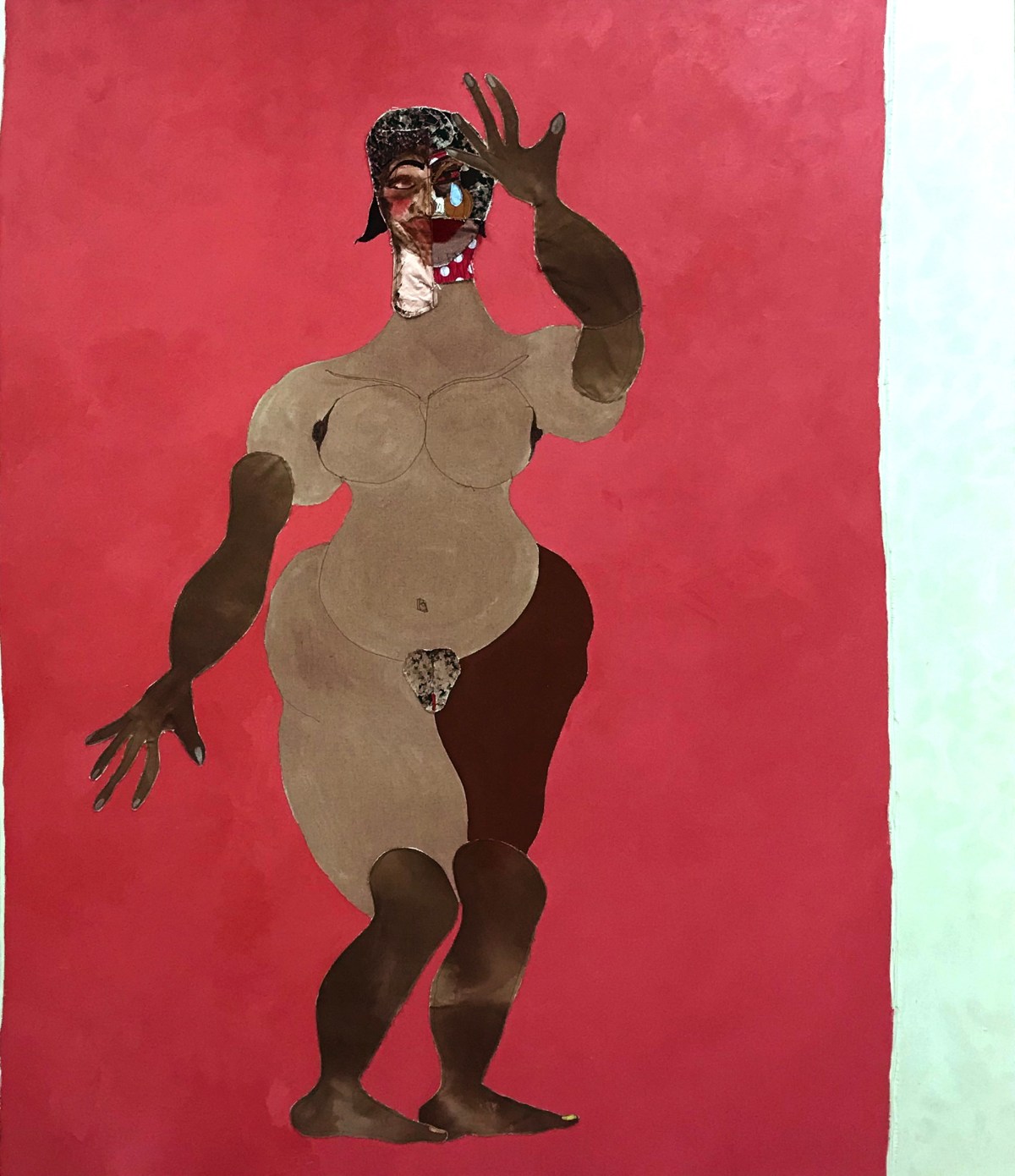
TSCHABALALA SELF
Damsel
2019
Acrylic, fabric, oil, colored pencil, painted canvas on canvas
213.5 x 183 cm / 84 x 72 in
SELF 48475
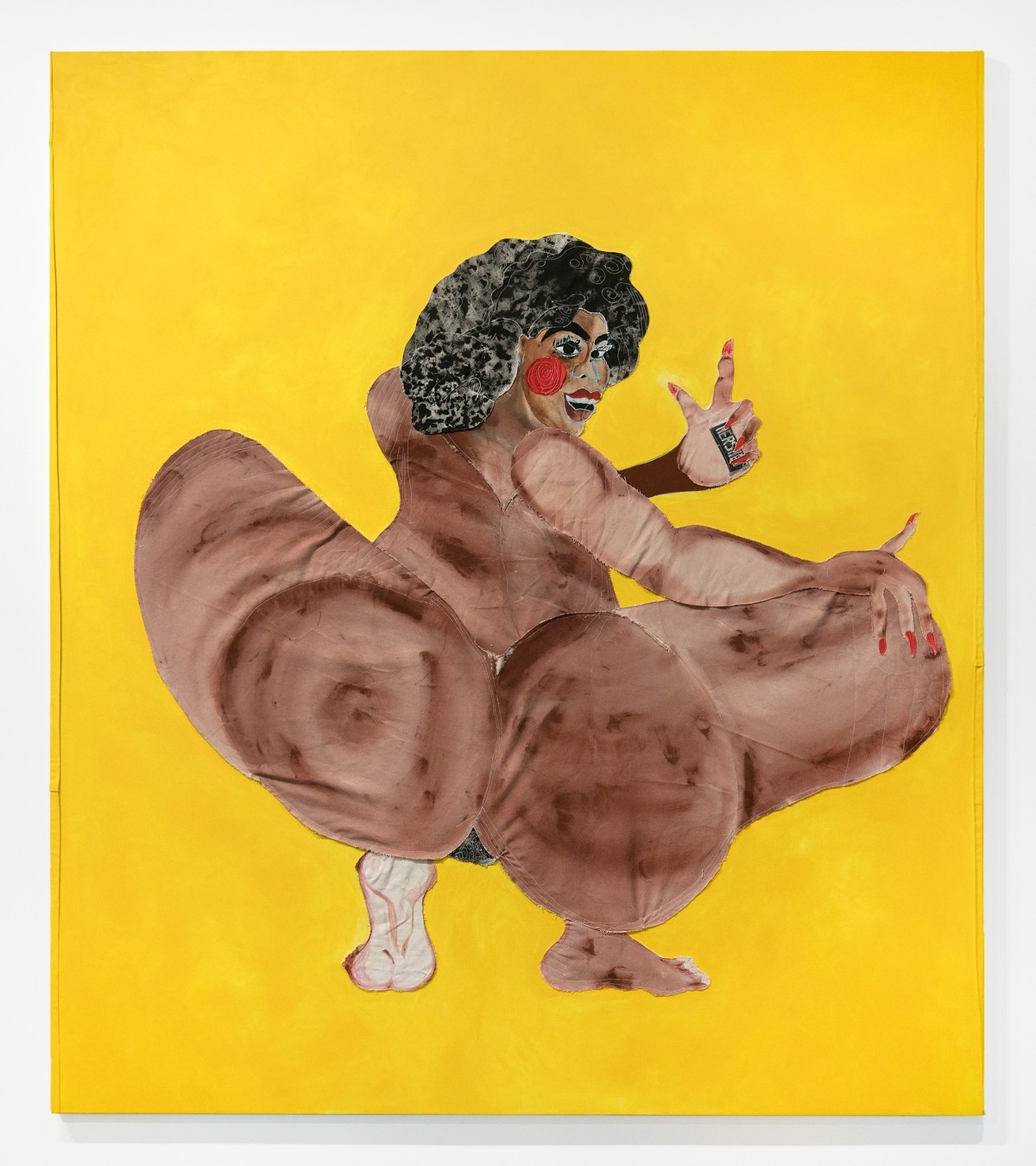
TSCHABALALA SELF
Milk Chocolate
2017
Gouache, acrylic, flashe, fabric and painted canvas on canvas
244 x 213.5 cm / 96 x 84 in
SELF 46902
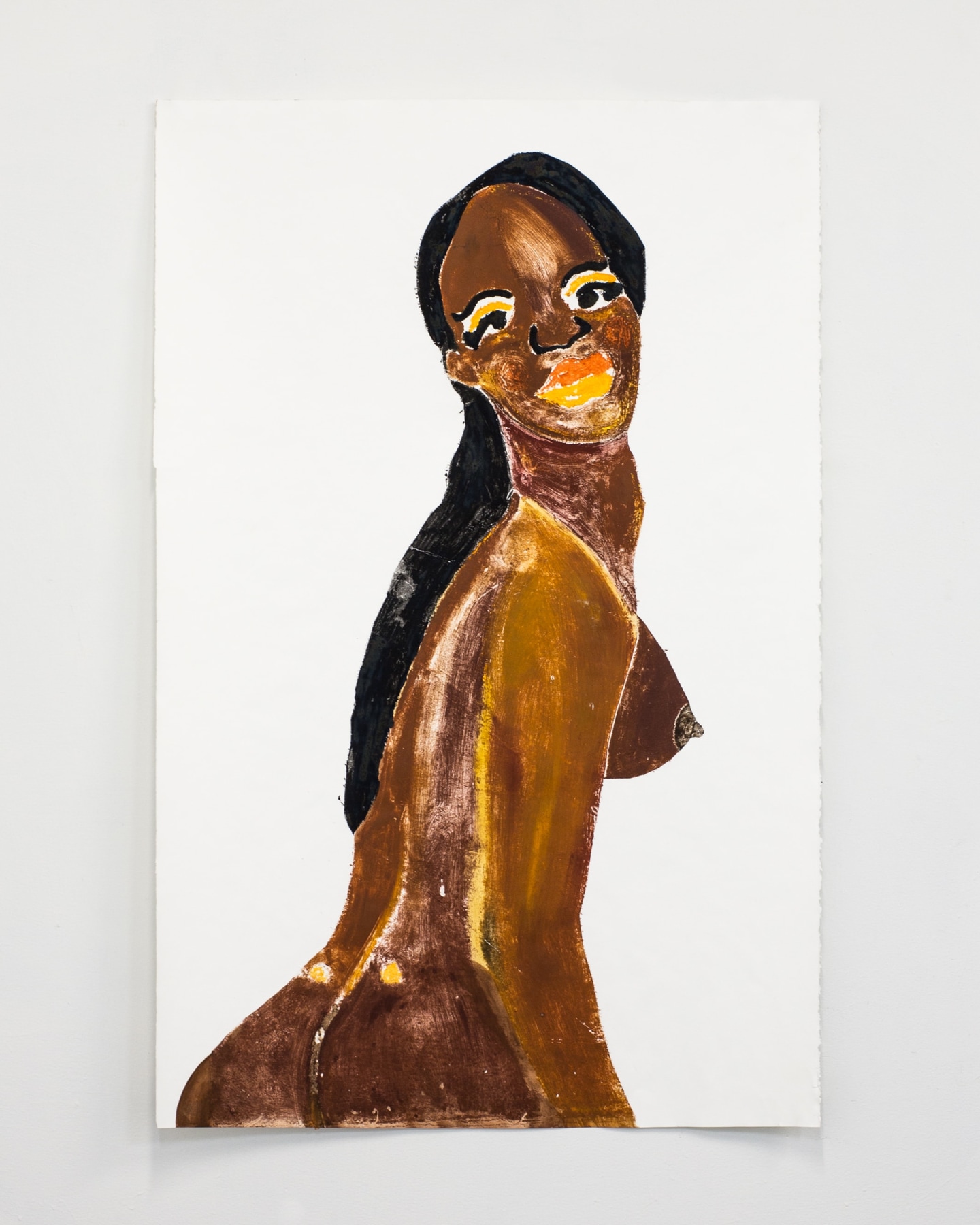
TSCHABALALA SELF
Coco
2013
Oil on paper
Sheet 112 x 76 cm / 44 x 30 in
Frame 117.5 x 78.5 cm / 46 1/4 x 30 7/8 in
SELF 46658
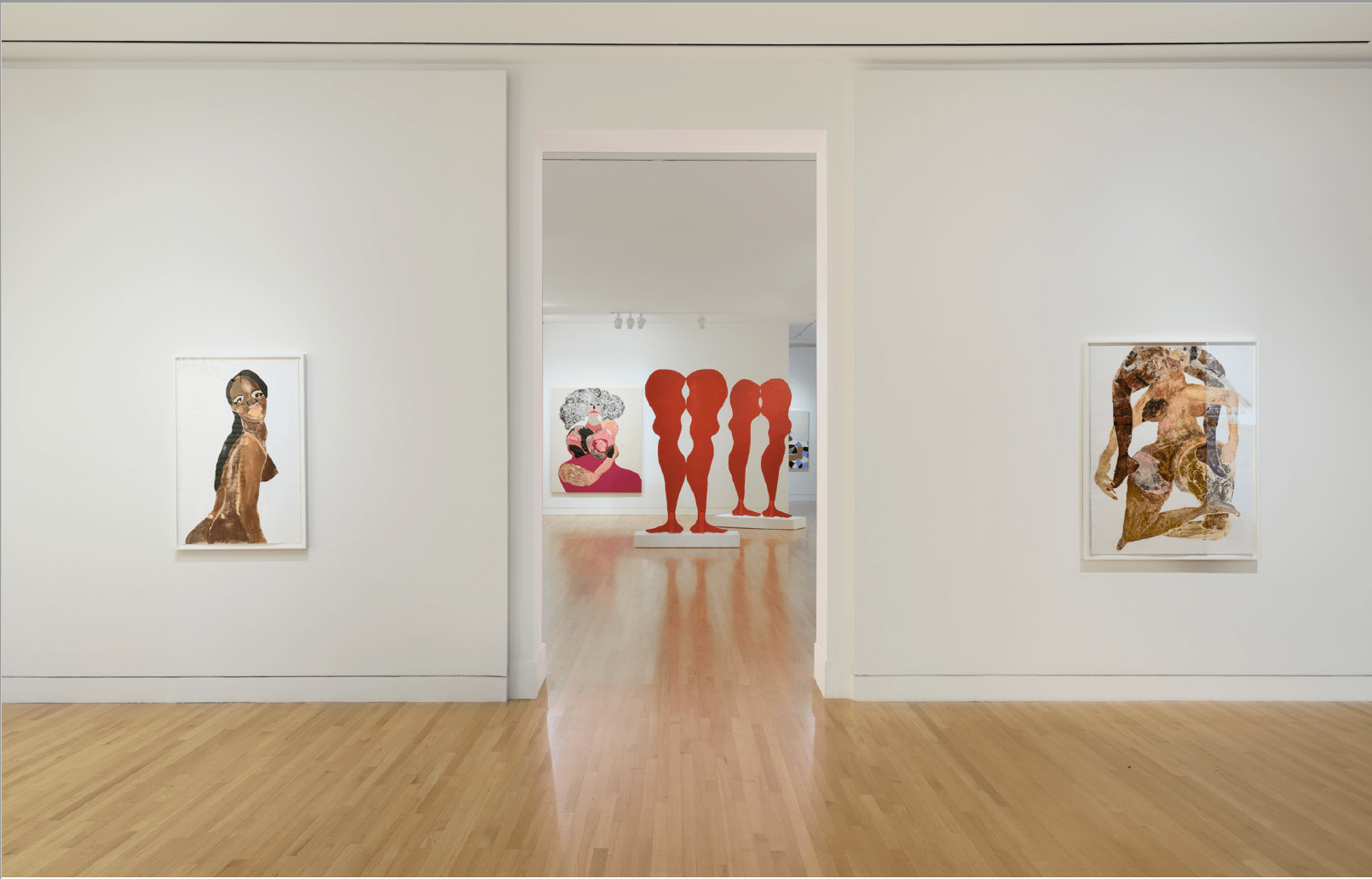
Installation view, Tschabalala Self, Frye Art Museum, Seattle, 2018
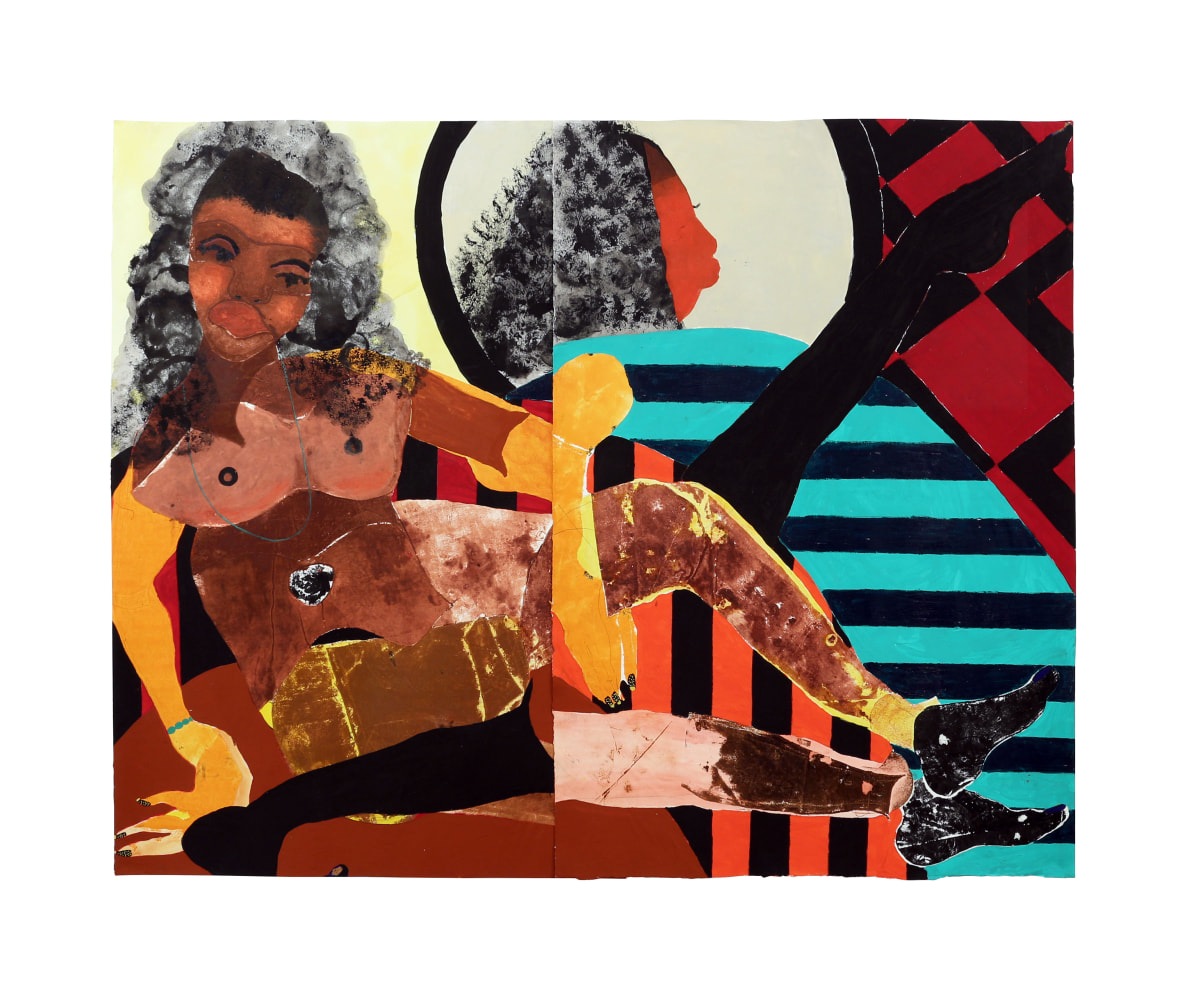
TSCHABALALA SELF
Pieces of Me
2015
Oil and acrylic on paper
112 x 152.5 cm / 44 x 60 in
SELF 46827
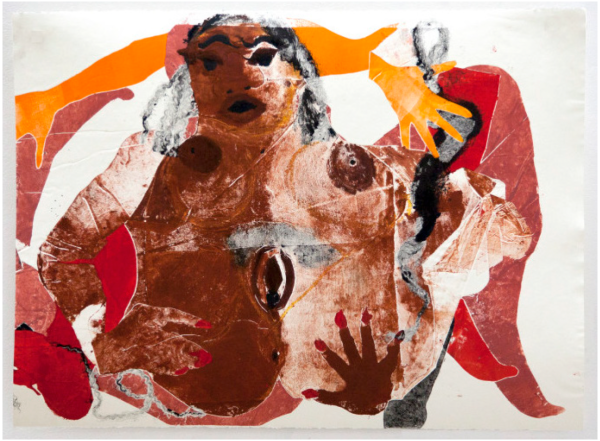
TSCHABALALA SELF
Origin of the New World
2014
Oil and acrylic on paper
76 x 112 cm / 30 x 44 in
SELF 46797
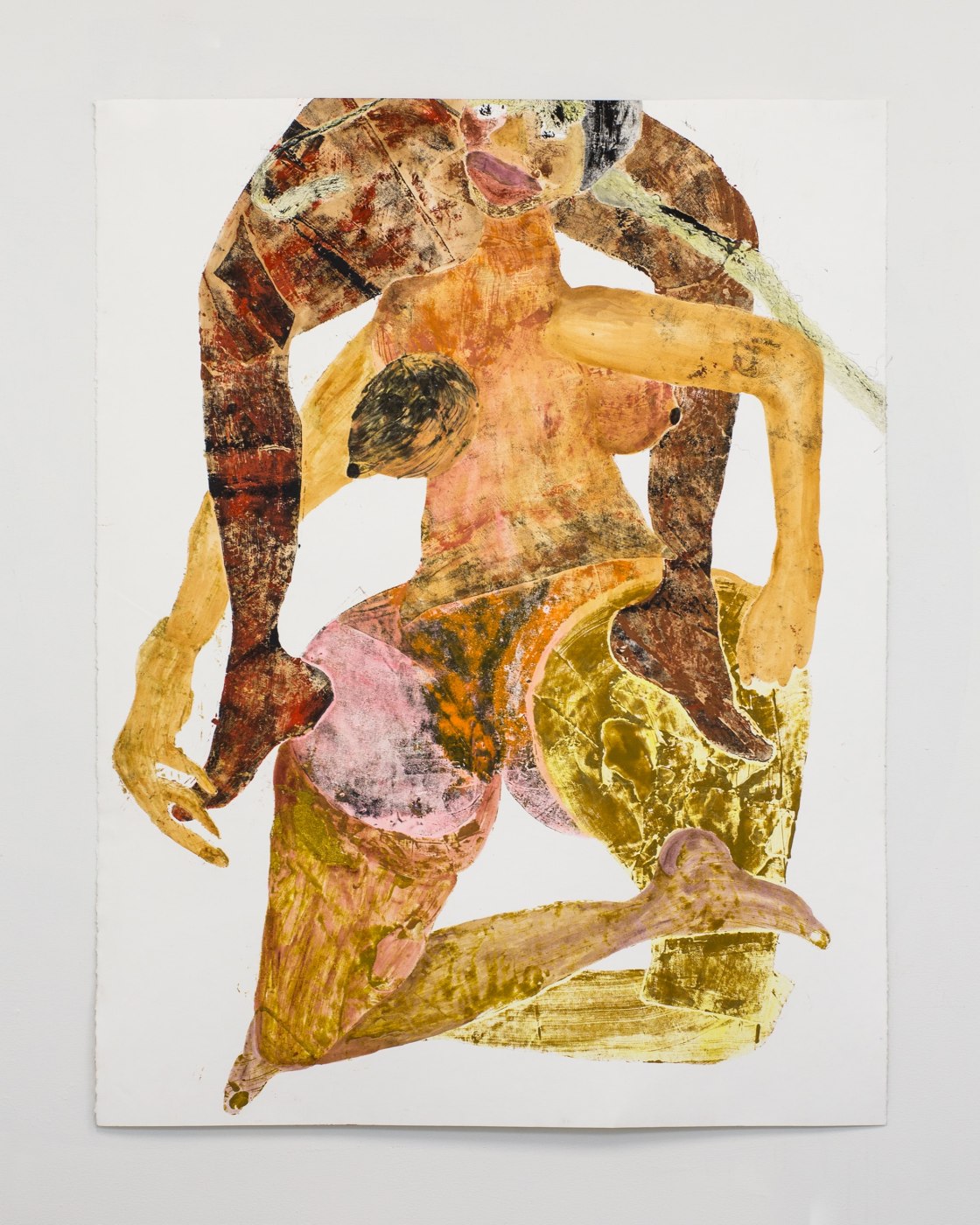
TSCHABALALA SELF
Entwined
2014
Oil and gouache on paper
Sheet 127 x 96.5 cm / 50 x 38 in
Frame 132.5 x 104.5 cm / 52 1/8 x 41 1/8 in
SELF 46888
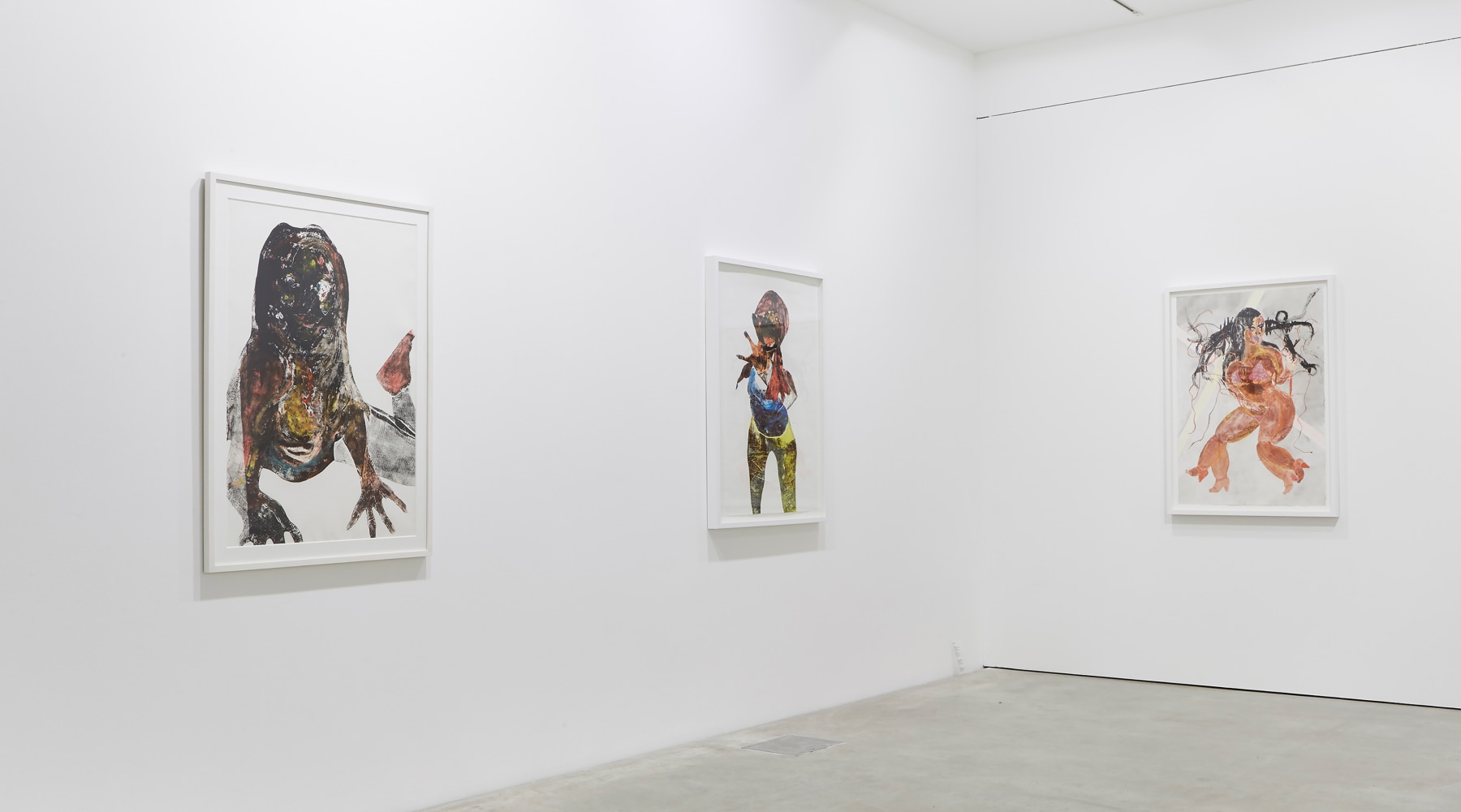
Installation view, Tschabalala Self, Parasol Unit Foundation for Contemporary Art, London, 2017
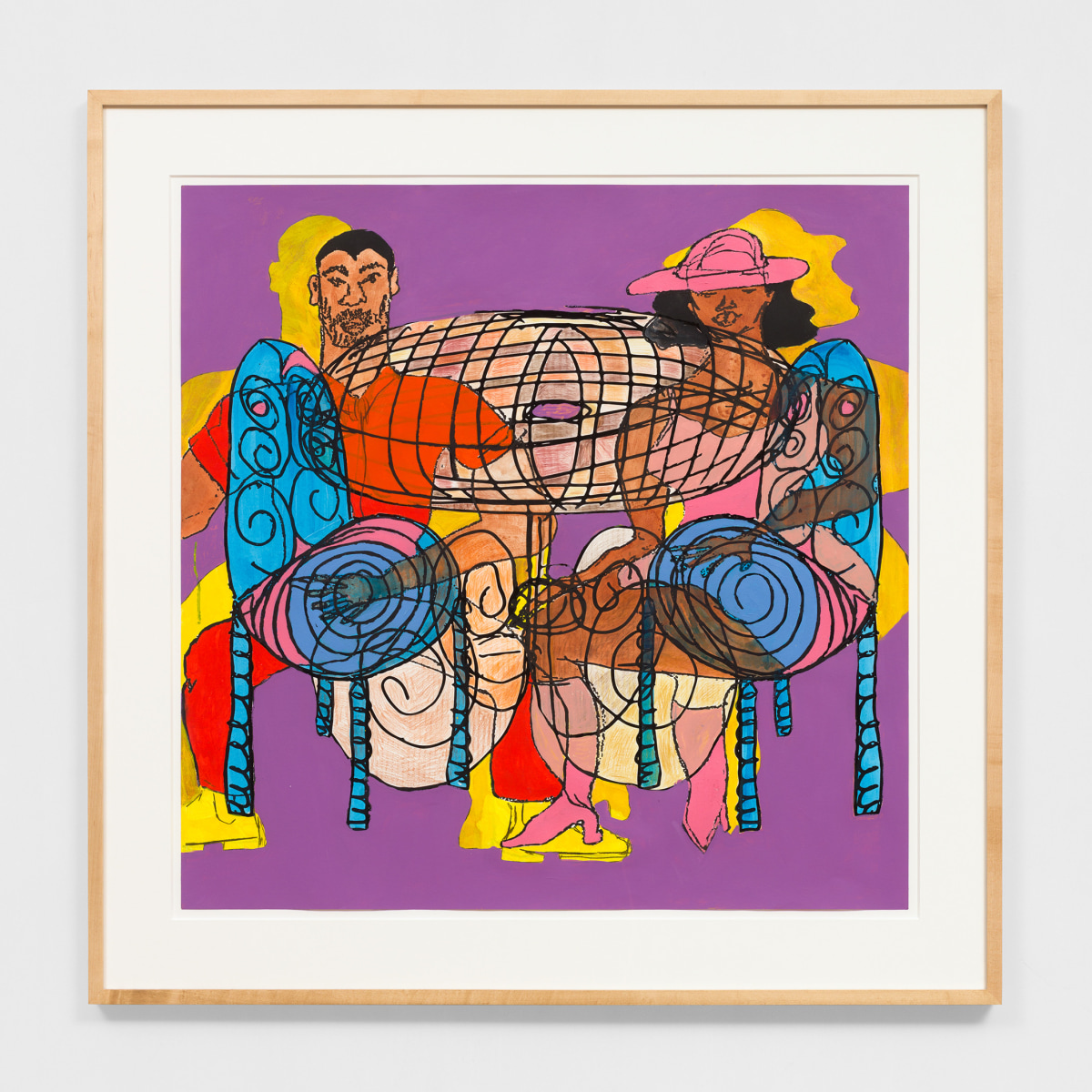
TSCHABALALA SELF
Seated Couple with Spiral Table
2021
Colored pencil, acrylic paint, gouache, charcoal, graphite on archival inkjet print
Unique
Image 91.5 x 91.5 cm / 36 x 36 in
Frame 114.5 x 114.5 cm / 45 x 45 in
SELF 50170
LEISURE DRAWINGS (2021 - 2022)
In these works, Self examines the notion of leisure as a gesture of refusal: of both the expectation or demand to perform and the ideal aspiration of the home as a place of refuge and relaxation.
Continuing the artist‘s blurring of public and private environments, these works introduce new iterations of the archetypal characters depicted in Self’s first live performance Sounding Board, which premiered at the 2021 Performa Biennial in New York City. Here, these hand-painted figures merge with depictions of Self’s furniture, a crucial prop from her performance, each contained within its own ‘home’ or unique painted environment.
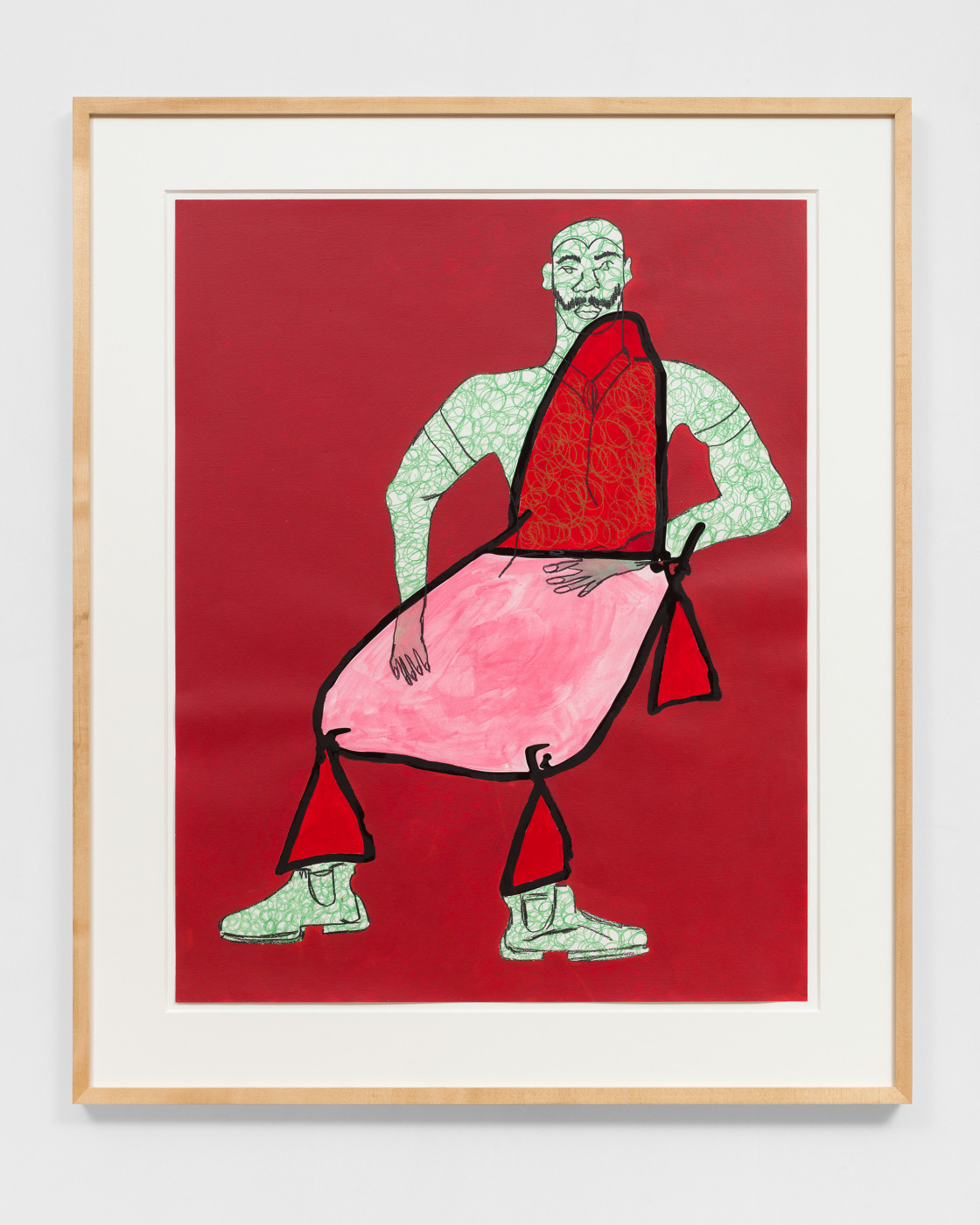
TSCHABALALA SELF
Green Man on Fat Leg Lounge #1
2021
Colored pencil, acrylic paint, gouache, charcoal, graphite on archival inkjet print
Unique
Sheet 91.5 x 72.5 cm / 36 x 28 1/2 in
Frame 114.5 x 95.5 cm / 45 x 37 1/2 in
SELF 50161
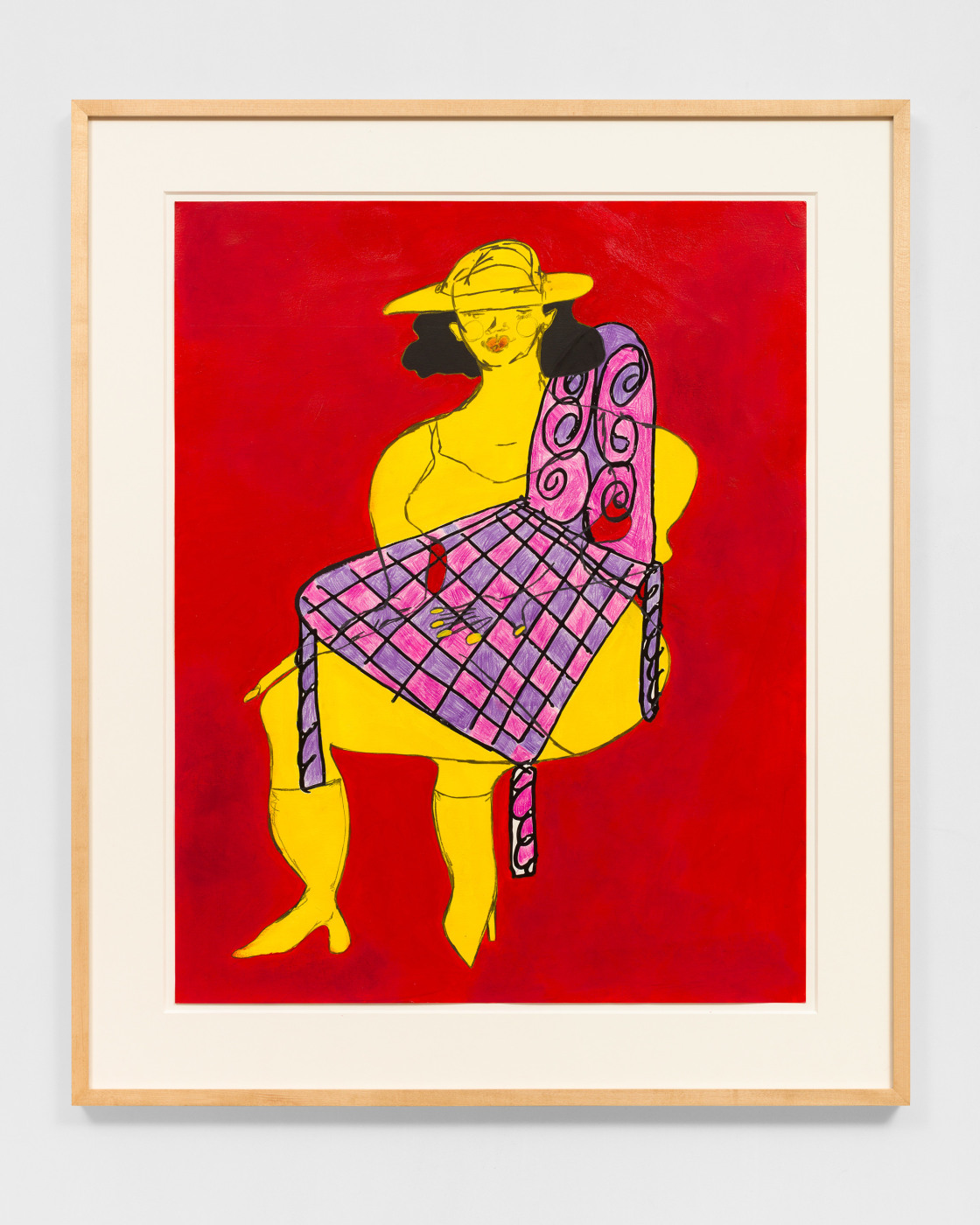
TSCHABALALA SELF
Yellow Lady on Wide Base Lounge #1
2021
Colored pencil, acrylic paint, gouache, charcoal, graphite on archival inkjet print
Unikat
Sheet 91.5 x 72.5 cm / 36 x 28 1/2 in
Frame 114.5 x 95.5 cm / 45 x 37 1/2 in
SELF 50152
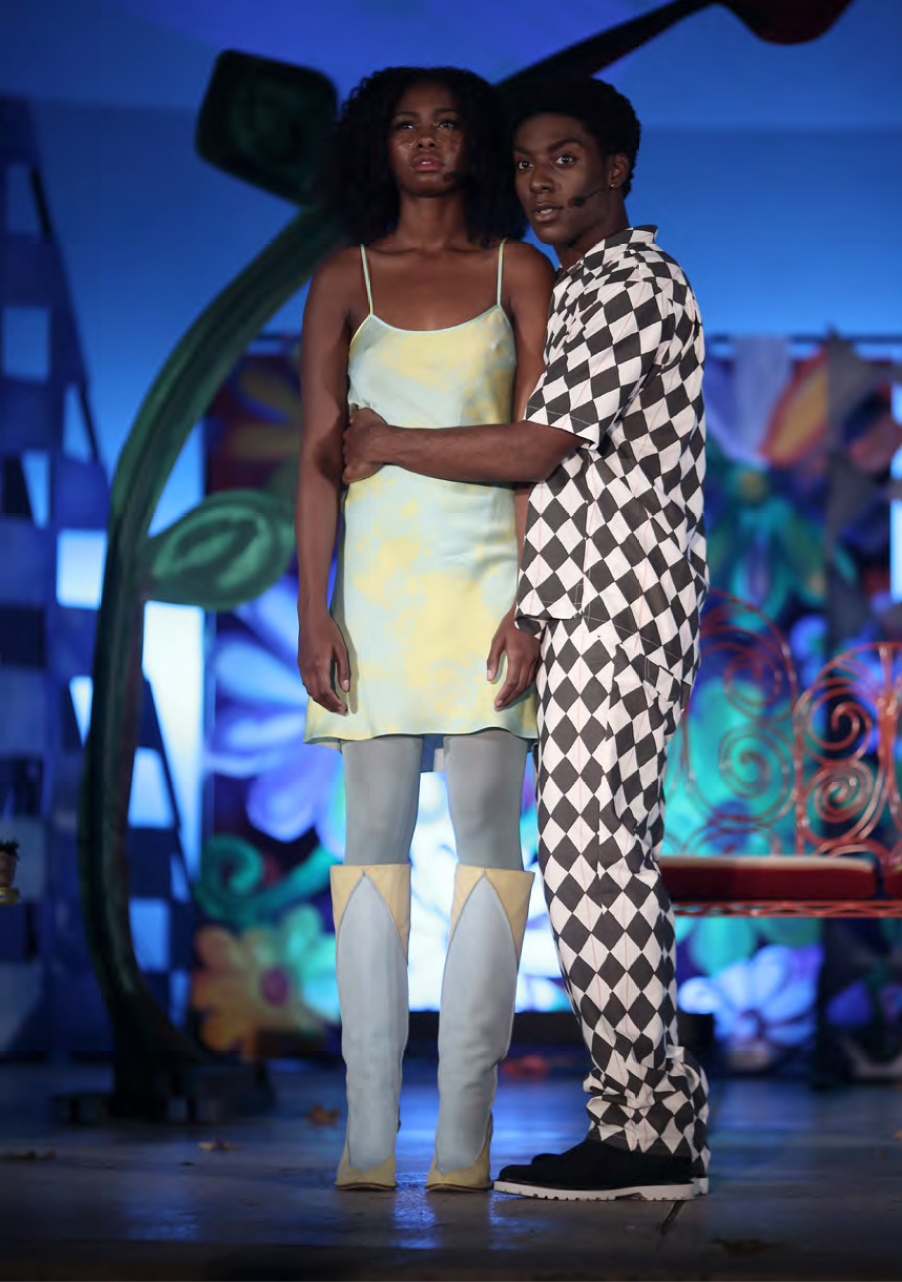
Tschabalala Self, Sounding Board, live performance at Performa Biennial, 2021, New York City
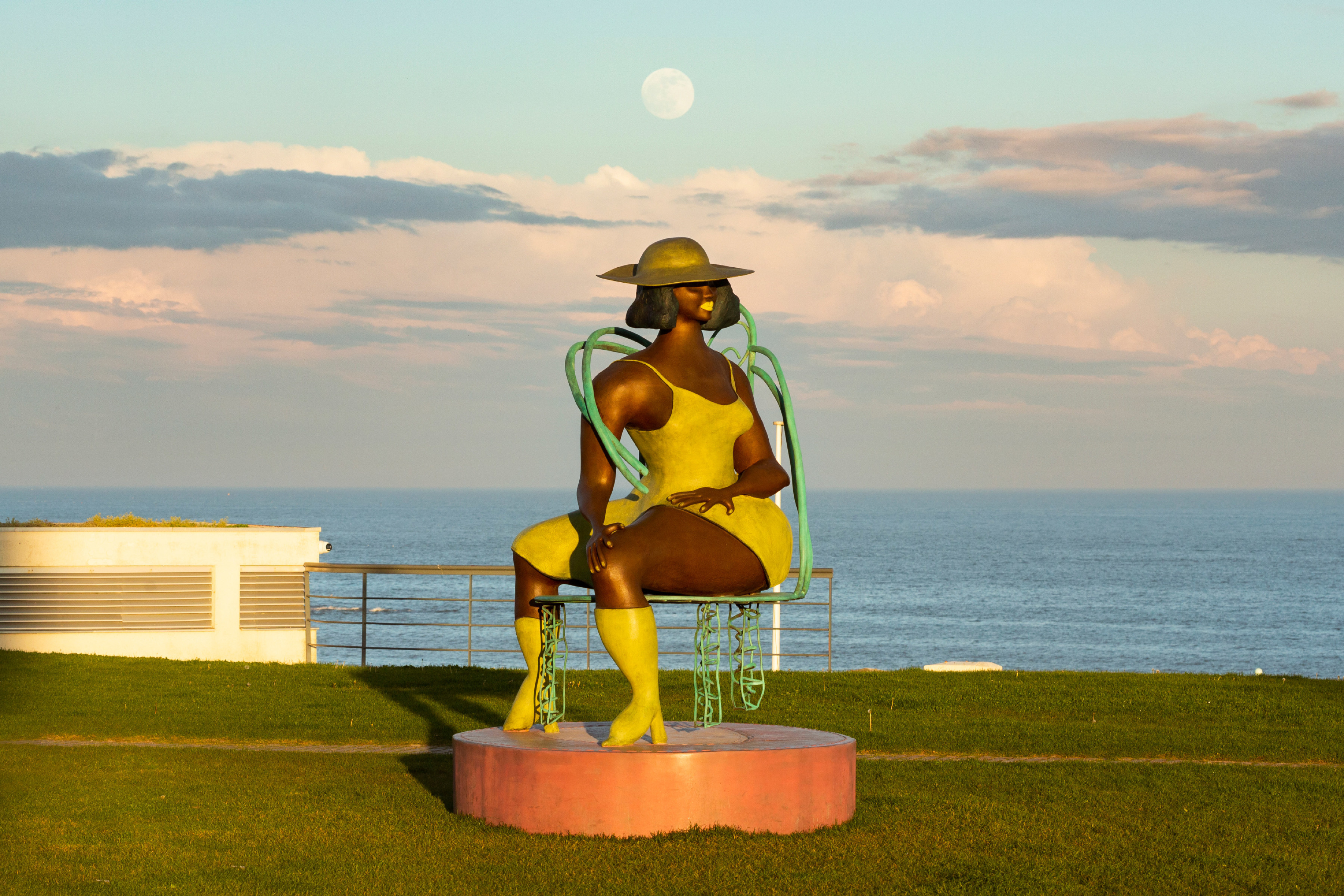
TSCHABALALA SELF
Seated
2022
Patinated bronze sculpture with stainless steel internal structure, hand-finished by the artist in oil paint
SELF 57077
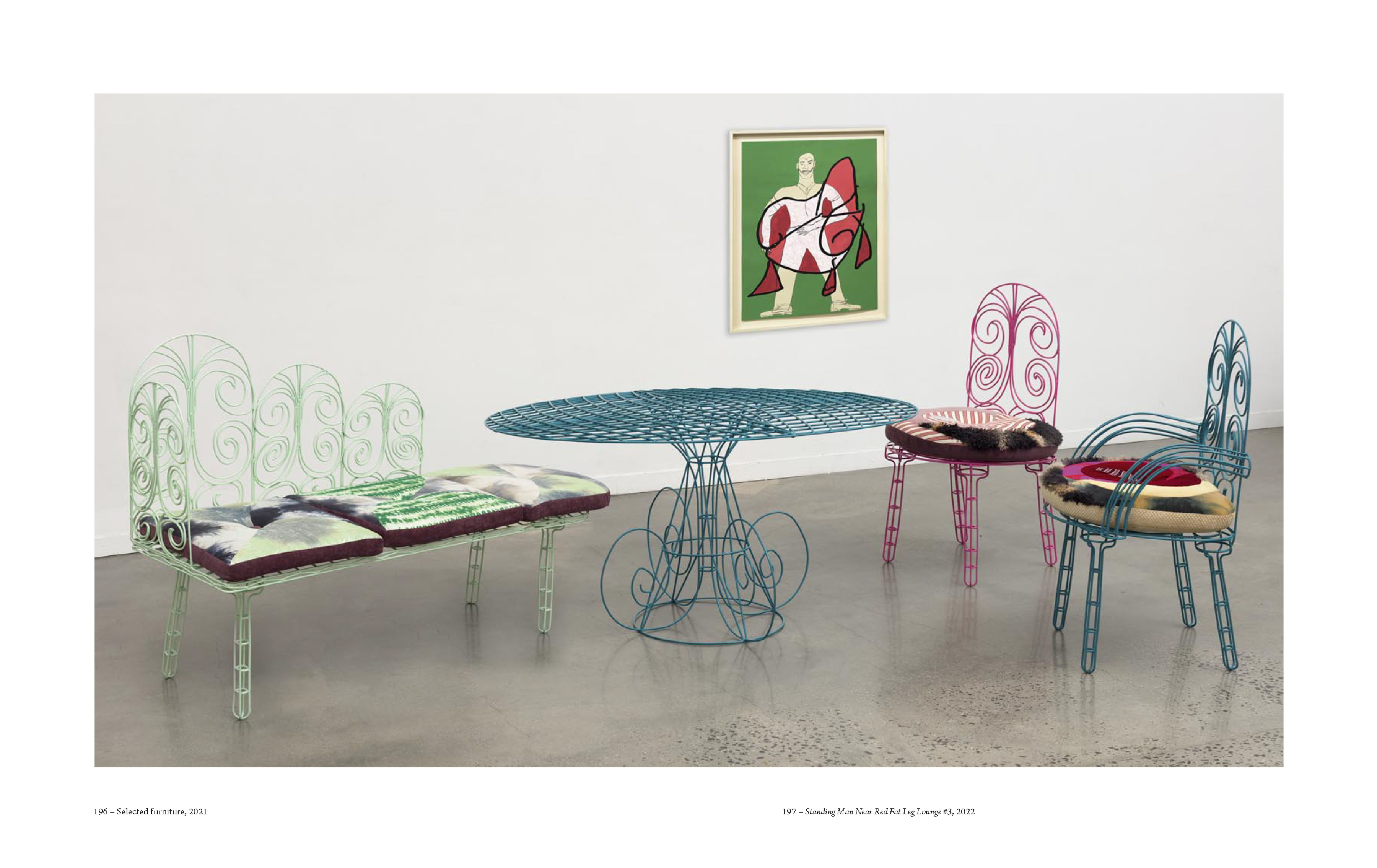
From: Franck Gautherot, Seungdug Kim, Tschabalala Self, Gwyneth Giller (edited by), Tschabalala Self. Make Room, Dijon, 2023, pp. 196 - 197
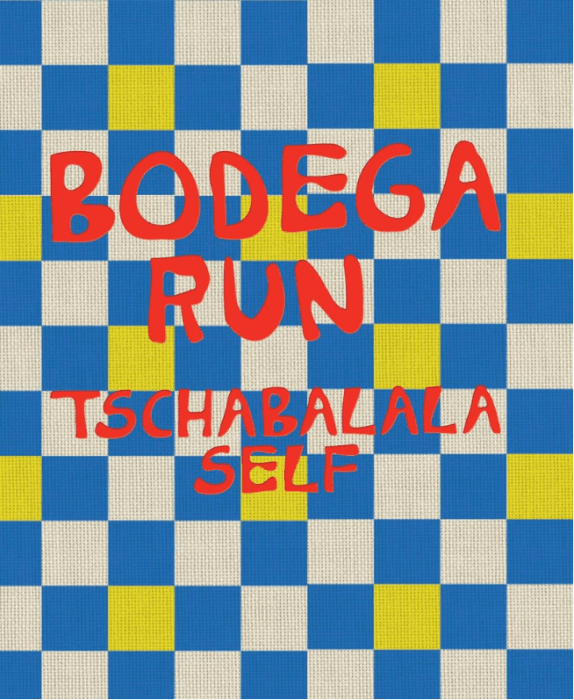
Tschabalala Self‘s Bodega Run will be published in January 2024
BODEGA DRAWINGS (2017 - 2019)
Bodega, a Spanish term, here refers to the family-run corner stores in New York where you can buy food, alcohol, lottery tickets and exchange food stamps. These institutions emerged with the arrival and settlement of Puerto Ricans and Dominicans to New York City, bodegas have become a social space where different communities of color converge. The stores are often found in areas where there are few supermarkets and are the only place where some urban communities can buy food. The food products are mostly processed or canned drawing a clear dichotomy on the disparity of wealth between the rich that can afford healthy eating and the poor who are left to exchange food stamps for unhealthy food products.
To Self, who was born and raised in Hamilton Heights in Harlem, bodegas at their best function as microcosms of cross-cultural exchange within the contemporary metropolitan African-diaspora; however, at their worst bodegas mirror the disparities projected upon communities of color by the society at large. The project is the first time that the artist has explored the possibilities and limitations of a real-life environment, focusing on the racism, segregation and wealth disparity in the US.
“A lighthouse in an ocean of gentrification, a relic from times past”. As Self suggested, “The bodega is and was a space created for people of color by people of color, to serve the needs of communities of color. A hood menagerie, the bodega is emblematic of black metropolitan life.”
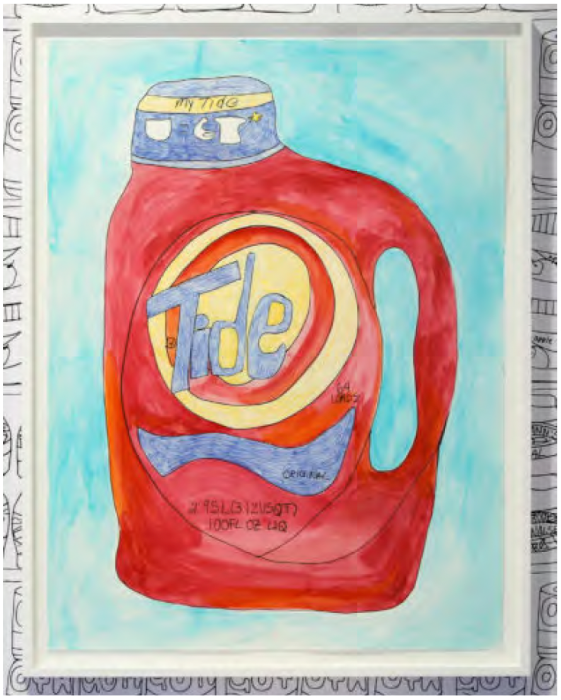
TSCHABALALA SELF
Red Soap
2018
Colored pencil, gouache, acrylic, and silkscreen on paper
89 x 66 cm / 35 x 26 in
SELF 46958
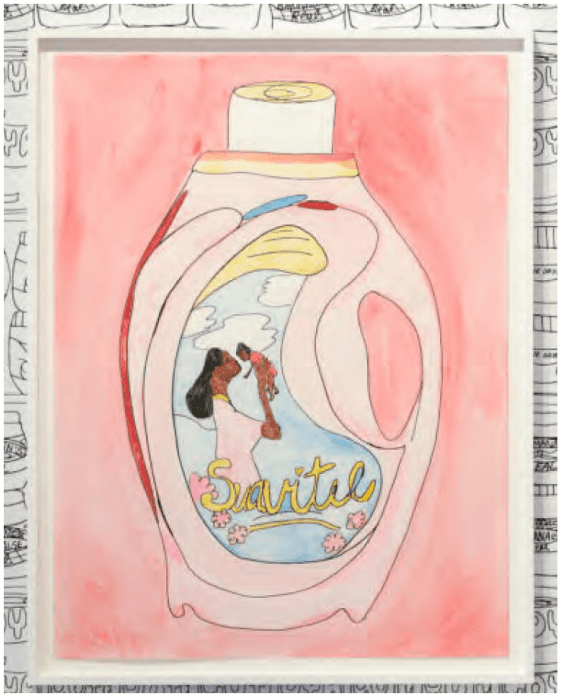
TSCHABALALA SELF
Pink Soap
2018
Colored pencil, gouache, acrylic, and silkscreen on paper
89 x 66 cm / 35 x 26 in
SELF 46963
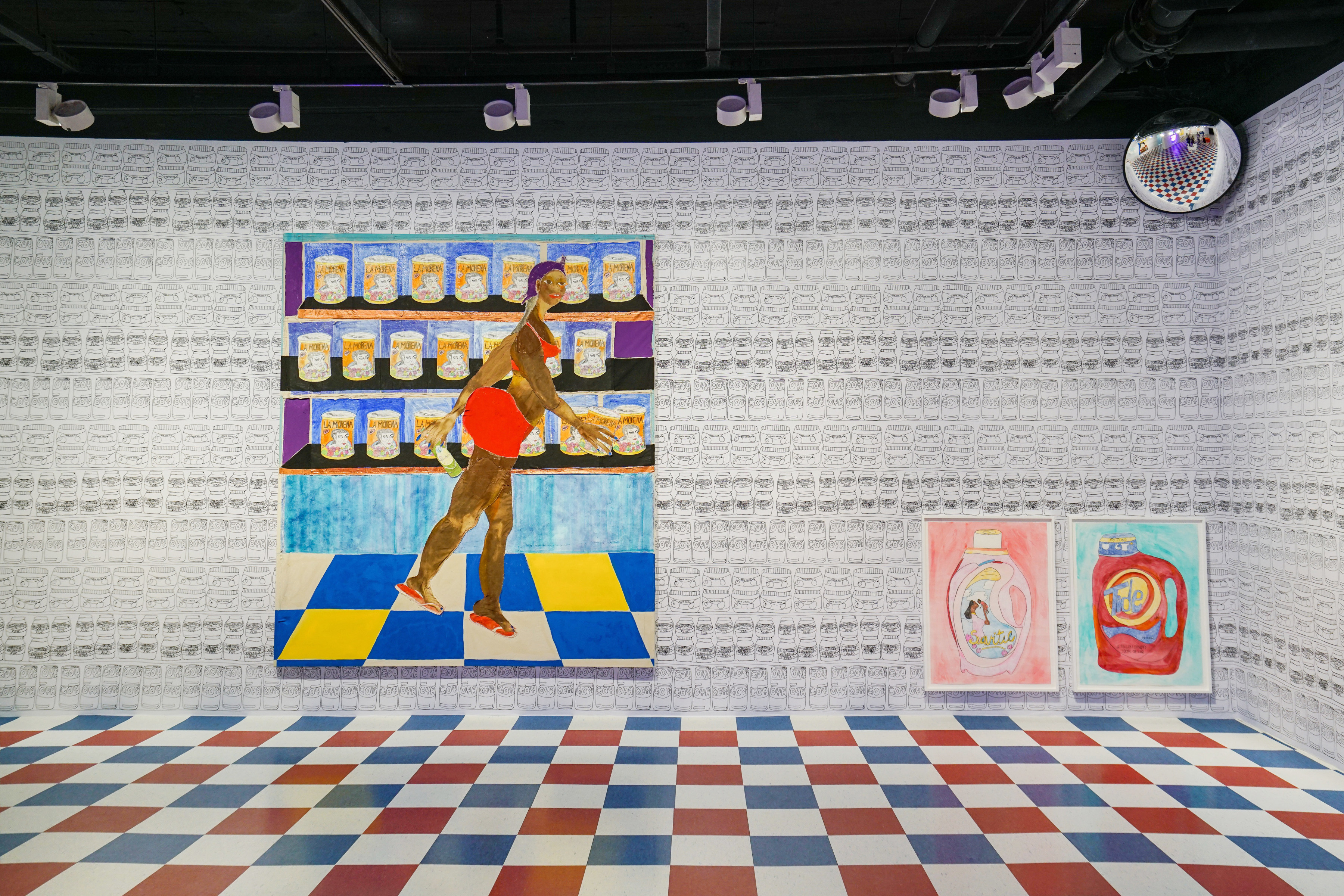
Installation view, Tschabalala Self, Bodega Run, Yuz Museum, Shanghai, 2018